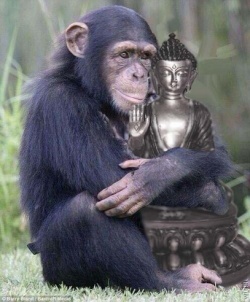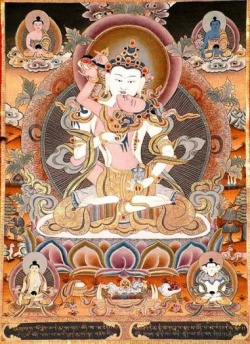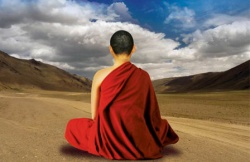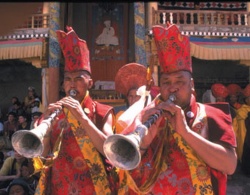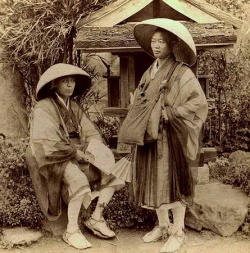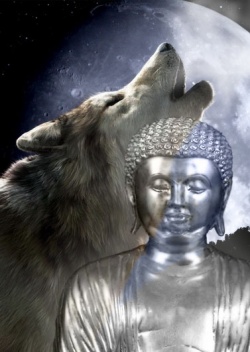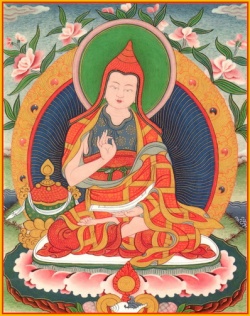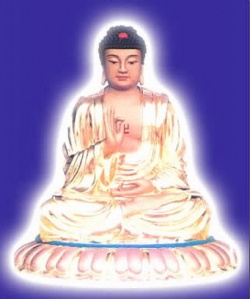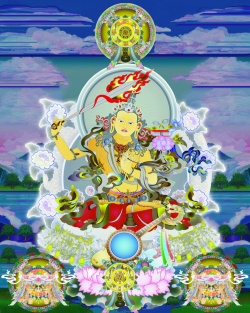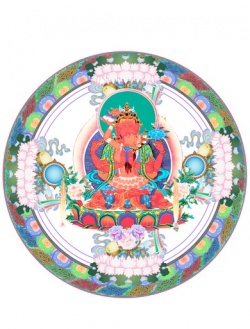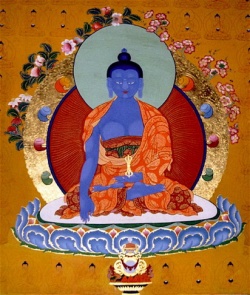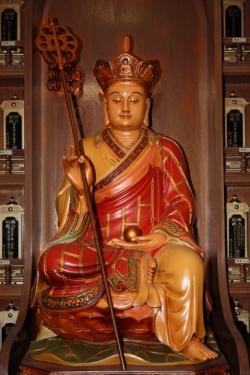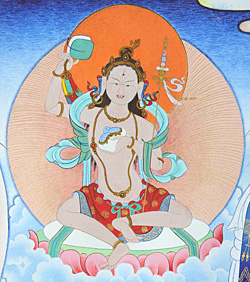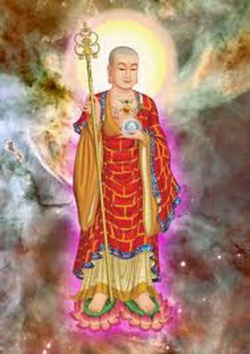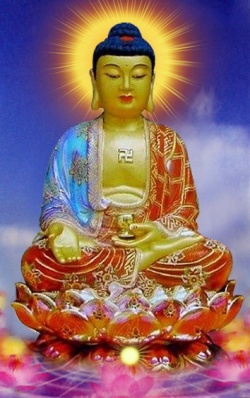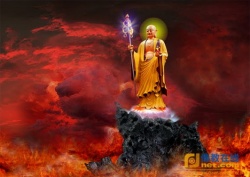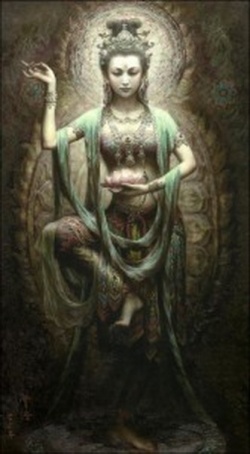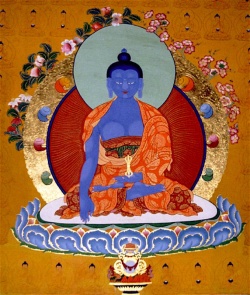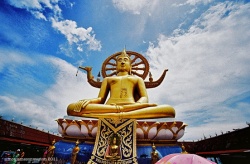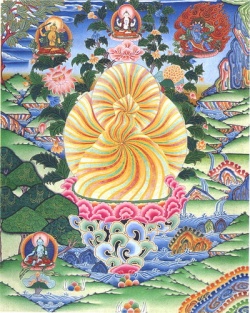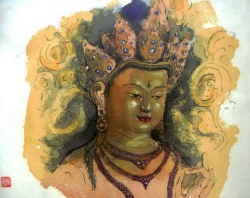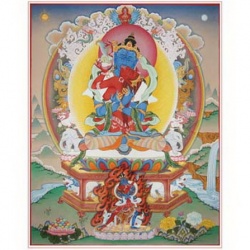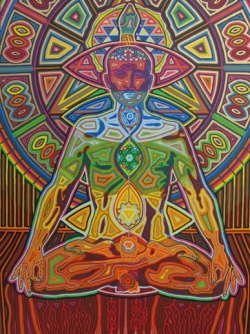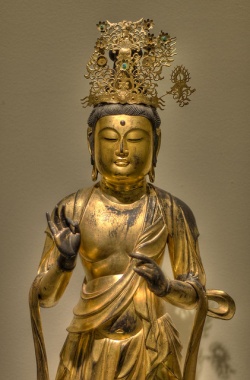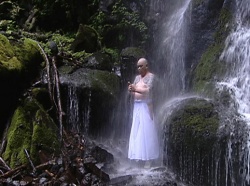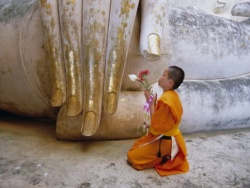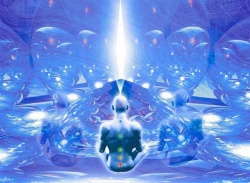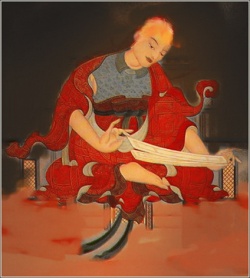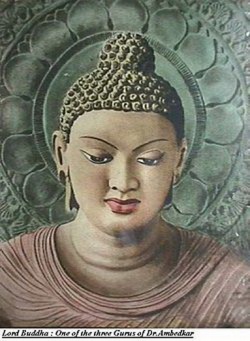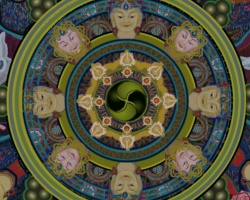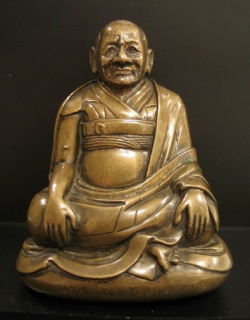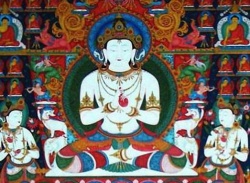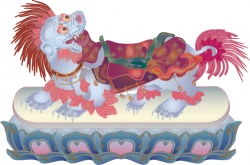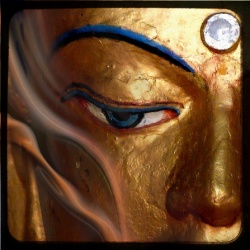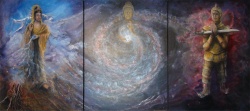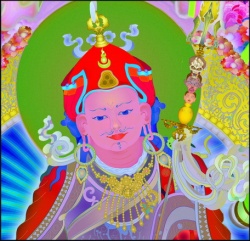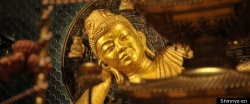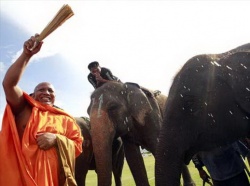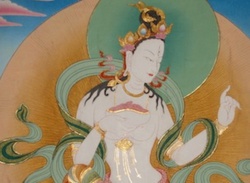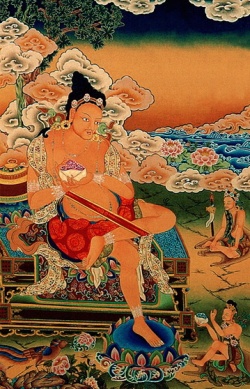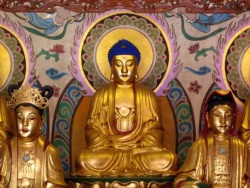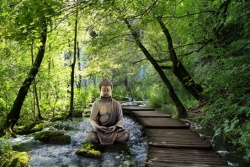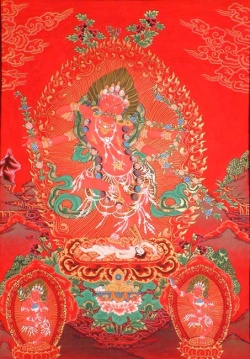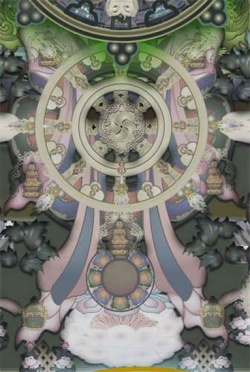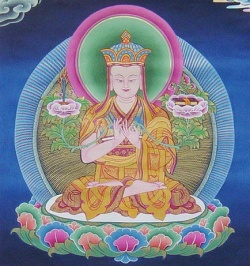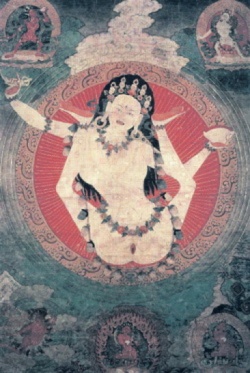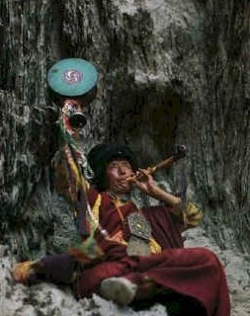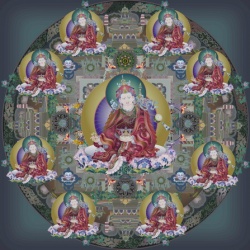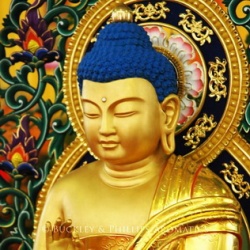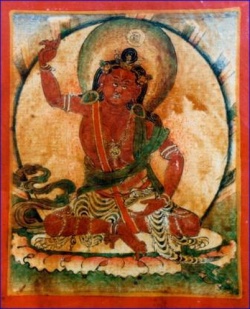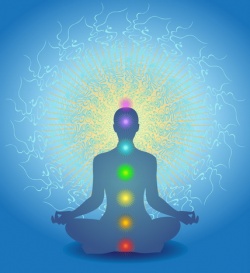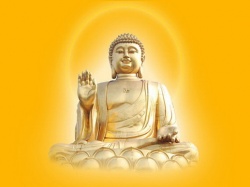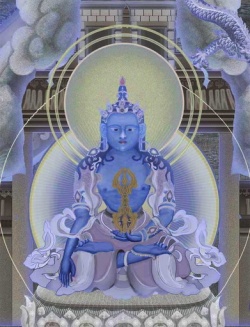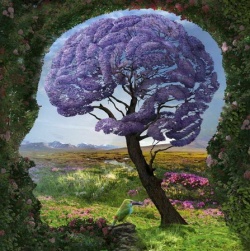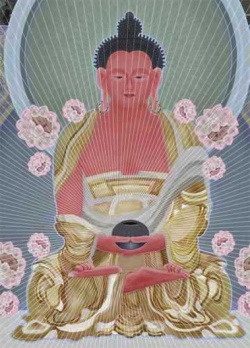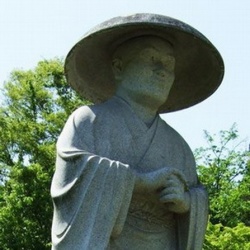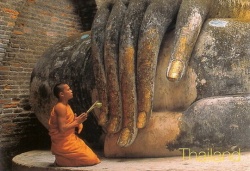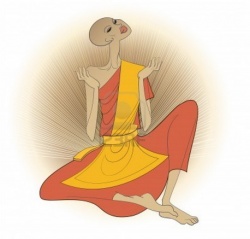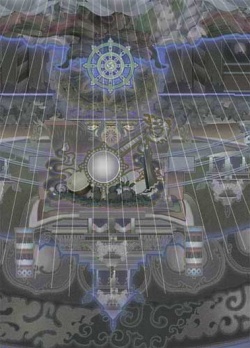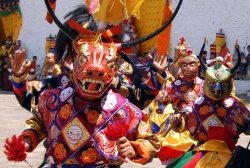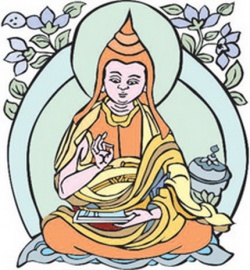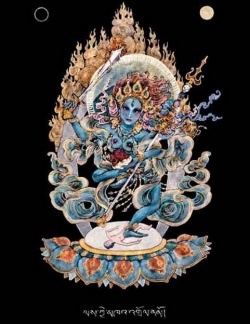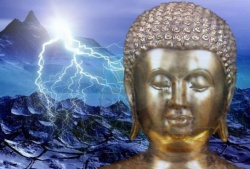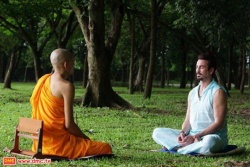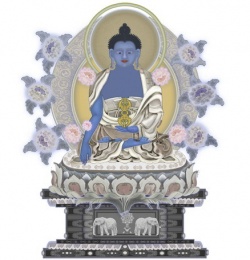Competing Tathāgatagarbha Theories in Tibet
William Magee, Ph.D.
Assistant Researcher, Chung-hwa Institute of Buddhist Studies
p. 445
Abstract
In this paper, historical materials are employed to point the reader toward scriptural sources for the tathāgatagarbha traditions of India and Tibet, including their relationship with theories of the mind-basis-of-all (kun gzhi rnam shes, ālayavijñāna).
In addition, three primary tathāgatagarbha traditions in Tibet are described and compared: those of the Jo-nang- following -rap-gyel-tsen (dol bo pa shes rab rgyal mtshan, 1292-1361), the Sa- following Bu-bu ston, 1290-1364), and the Ge-luk- following (tsong kha pa, 1357-1419).
Doctrines concerning the basic constituent (khams, dhātu) and three buddha bodies are examined insofar as these doctrines shed light on theories of tathāgatagarbha. Since ‚ extensively refuted the Jo-nang position─often called Other Emptiness (gzhan stong)─in his Treatise Differentiating Interpretable and Definitive Meanings:
The Essence of Eloquence (drang ba dang nges pa’i don rnam par phye ba’i bstan bcos legs bshad snying po) and other works on the philosophical view of emptiness, this paper examines ‚'s discussion and critique of the Jo-nang Other Emptiness.
Ten specific criticisms of Other Emptiness made by ‚ and his followers are compared with presentations of Other Emptiness by Jo-nang authors.
Two Jo-nang texts recently translated by Professor Jeffrey Hopkins are employed in this comparison: -rap-gyel-tsen’s Mountain Doctrine, Ocean of Definitive Meanings (ri chos nges don rgya mtsho) and Tāranātha’s Essence of Other Emptiness ([[gzhan stong snying po\\).
These comparisons show that ‚ critique does not always accurately reflect the Jo-nang philosophical view.
關鍵詞:1.Tibet 2.tathāgatagarbha 3.Buddha matrix 4.Other Emptiness 5.Jo-nang 6.Ge-luk 7. 8.-rap-gyel-tsen 9.Middle Way School 10.Mind-only School 11.mind-basis-of-all
Tathāgatagarbha and the Mind-basis-of-all
Sūtra Sources
The Basic Constituent
Three Buddha Bodies
Tathāgatagarbha Treatises in Tibet
The Jo-nang- and Their Critics
Ge-luk- Following ‚
Conclusion
In his ground-breaking work on the buddha matrix[1], Le Traité sur le Tathāgatagarbha et du Gotra, David Seyfort Ruegg mentions three primary tathāgatagarbha traditions in Tibet:[2]
˙Jo-nang-[3]following -rap-gyel-tsen[4](1292-1361)
˙Sa-ḡya-[5]following Bu-[6](1290-1364)
˙Ge-luk-[7]following ‚[8](1357-1419).
The positions of Bu- and ‚ are similar in that both assert a negative—an emptiness of inherent existence—as the buddha matrix.
For Bu- this is the emptiness of inherent existence of the mind of a Buddha, whereas for ‚ it is the emptiness of inherent existence of the mind of an ordinary being. -rap-gyel-tsen—charismatic founder of the Jo-nang sect and perhaps Tibet's leading exponent of Other Emptiness—puts forward a positive theory of tathāgatagarbha: he sees the buddha matrix as a self-knowing, self-illuminating, primordially pure exalted wisdom within each being; permanent, stable, and eternal; adorned with the marks and beauties of a tathāgata.
These negative and positive buddha matrix theories compete for primacy in Tibetan Buddhism even to this day. In particular, the positions of -rap-gyel-tsen and ‚ have not co-existed gently in the land of snows. Although the main thrust of Ge-luk-b̄a scholasticism is toward an exegesis of emptiness, tathāgatagarbha doctrines nevertheless occupy an important place in the Ge-luk religious system, and are closely involved with the topics of emptiness, interpretation of scripture, soteriology, and so forth. Thus, this is not a small doctrinal dispute, but utterly central to the Ge-luk scholastic edifice. Therefore ‚ extensively refuted the Jo-nang position (often called Other Emptiness[9]) in his Essence of Eloquence.[10]Despite concerted efforts to suppress -rap-gyel-tsen’s view, the Jo-nang view of Other Emptiness survived Ge-luk deprecations—it had already spread throughout Tibet—but the Jo-nang establishment was sadly reduced; so much so, in fact, that at the time of Ruegg’s composing his Théorie du Tathāgatagarbha et du Gotra, European and American scholars did not have access to the works of -rap-gyel-tsen. Instead, Ruegg and others who wrote about Jo-nang were forced to rely for information about it on descriptions found in the works of its critics. Today, however, thirty-five years later, Jo-nang scriptures once thought lost have been found. Authentic information about 's view of Other Emptiness is now available.
As in most Buddhist traditions throughout the Mahāyānist world, the tathāgatagarbha serves spiritually and doctrinally as a positive counterfoil to the negative dialectic of selflessness. This is because the overt message of tathāgatagarbha is not that all phenomena are selfless and empty of inherent existence, but that all beings are endowed with an element of perfectability.
Although this element of perfectability is interpreted within Ge-luk to refer to the emptiness of the mind of a non-Buddha, even in that apophatic atmosphere the positive aspect of tathāgatagarbha still serves to remind the practitioner of the immanence of enlightenment, as well as of the religious goal: the infinite good qualities of a Buddha. Thus, for Ge-luks and many others, these doctrines are a positive expression of an otherwise negative emptiness, rounding out the Middle Way presentation of emptiness by presenting an underlying ontological garbha enabling progress to Buddhahood. The benefits of this presentation are so great that, according to some non-Ge-luk traditions, the tathāgatagarbha fulfills the true meaning of emptiness, insofar as it does not one-sidedly speak of emptiness, but includes the noumenal qualities of a Buddha in the realm of the ultimate.[11]
In this paper, historical materials will be employed to point the reader toward sources for the tathāgatagarbha tradition. I will briefly look at doctrines concerning the basic constituent[12]and three Buddha bodies insofar as these doctrines shed light on theories of tathāgatagarbha. The fact that Tibetan discussions of tathāgatagarbha often come in conjunction with presentations of the tenets of the Middle Way School and the Mind-Only School seems to point to an historical basis of association with both these schools. However, historical evidence regarding the genesis of tathāgatagarbha in India is incomplete. The best that can be said is that these teachings appear not to have comprised a separate school, but were associated with and eventually absorbed into the more mainstream traditions of the Mahāyāna.
In order to compare and contrast interpretations of tathāgatagarbha that have been influential in Tibet, I have already mentioned the Ge-luk-b̄a presentation of the tathāgatagarbha, wherein the tathāgatagarbha is identified as the emptiness of the mind of non-Buddhas. This contrasts sharply with the Jo-nang-b̄a presentation of a permanent stable tathāgatagarbha adorned with the major and minor marks of a Buddha.
The Jo-nang- were a school of Kālachakra practitioners, still existing today,
that flourished from the thirteenth to the seventeenth centuries in Tibet.[13] They drew upon Indian sources to assert a permanent stable tathāgatagarbha that is a buddha, adorned with the major and minor marks of a buddha, existing in the continuums of all beings. That this permanent stable tathāgatagarbha is empty of being any conventional thing is the true meaning of emptiness for Jo-nang-.
The Ge-luk-, however, dispute that these Indian sources teach such a permanent stable tathāgatagarbha at all. Since the Middle Way school identifies the basis in Buddha’s thought when he spoke of a permanent stable essence as emptiness, and since the Mind-Only School[14]identifies the basis in Buddha’s thought when he spoke of a permanent stable essence as being the mind-basis-of-all,[15]Ge-luk- assert that neither of the two major branches of Indian Mahāyāna accept a permanent stable essence, endowed with all the marks of a Buddha, as being of definitive meaning (Sa- following Bu- accept that these sūtra sources teach such a permanent stable tathāgatagarbha, but they disagree with the Jo-nang- by asserting that such does not exist in the minds of non-buddhas).
Numerous Hīnayāna and Mahāyāna sūtras and treatises speak of the existence of a quality or matrix within beings that enables spiritual transformation and results in Buddhahood. As mentioned above, some sūtras call this matrix the tatāgatagarbha. At least one scripture—specifically, an unknown sūtra passage quoted in the Descent into Laṅkā Sūtra[16]—mentions the existence within each being of a permanent stable tathāgatagarbha endowed with the major and minor marks of a buddha. Other scriptures speak of a naturally abiding lineage[17]as the "cause" of enlightenment. There is also the important related theme of the three Buddha Bodies.[18]Each of
these terms will be discussed below.
In the early centuries of Indian Buddhism (up to 600 A.D.), tathāgatagarbha teachings played an important if subsidiary role in the major schools of the Mahāyāna, as well as in some Hīnayāna schools.[19]However, since there is no clear evidence in India of an extensive tathāgatagarbha commentarial tradition, the literary, philosophical, and religious origins of these teachings remain obscure.[20]Gregory asserts that the tathāgatagarbha group of doctrines arose as an original school, but was absorbed into the more influential Middle Way and Mind-Only Schools.[21]It was these two Schools which emerged as the dominant forms of Indo-Tibetan Buddhism. Thus, historical developments in India affected the later perspective of the Tibetans when confronted with tathāgatagarbha teachings.
Many scholars consider the Lion’s Roar of Queen Shrīmālā Sūtra[22]to be the oldest of the extant tathāgatagarbha group of sūtras. Wayman states that it was a Mahāsāṅgika composition.[23]He reasons that since chapter three of this text is the most quoted sūtra chapter in Maitreya’s[24]Treatise on the Later Scriptures of the Great Vehicle,[25]it must have been a basic primer for the study of tathāgatagarbha in the early Mahāyāna.[26]If indeed The Lion’s Roar of Queen Shrīmālā constituted an early pre-Mahāyāna scripture on the tathāgatagarbha, it is interesting to note in this context that Conze states that some Mahāsaṇghikas equated emptiness with the
tathāgatagarbha:
. . . identified emptiness with the nature of the Buddha. For them, ‘all beings, both worldly and supramundane, have the Void for their basis. The Void is the Buddha nature and the great final nirvāṇa. The Buddha nature must therefore necessarily exist in all beings.[27]
If Conze is correct in this identification of the tathāgatagarbha and emptiness within the Hīnayāna Mahāsaṇghika School, then this would be an early manifestation of the later Mahāyāna Middle Way School identification of the emptiness of the mind of a sentient being as the tathāgatagarbha. Gregory seems to be in agreement with this when he remarks that the tathāgatagarbha doctrine "provided a clear rationale for sublating the Mādhyamika teaching of emptiness into a more kataphatic doctrinal framework."[28]In short, by teaching the tathāgatagarbha, the Buddha was able to benefit trainees who were otherwise unable to make use of the teaching of emptiness.
The Descent into Laṅkā Sūtra presents one such problem that trainees might have with emptiness:
So that children might avoid the fear of selflessness, they teach through the means of a tathāgatagarbha the state of non-conceptuality, the object [of the wisdom) free from appearances.[29]
Gregory remarks that, at least in China, the tathāgatagarbha was often considered the most ultimate teaching insofar as it presented a completely rounded view of emptiness including the positive qualities of the Buddha.
Tathāgatagarbha and the Mind-basis-of-all
An important trend in the development of the tathāgatagarbha group of doctrines is the association of the tathāgatagarbha and the mind-basis-of-all[30]. In general, Proponents of Mind-Only assert a mind-basis-of-all that is a repository of seeds or predispositions. This consciousness takes rebirth, carrying with it the person’s unactivated karmic seeds.[31] This association is spoken of in at least two sūtras, these being the Descent into Laṅkā Sūtra and the Sūtra on the Heavily Adorned.[32] The Sūtra on the Heavily Adorned says:
[Just as] lands [are the basis of] the varieties [of all things grown],
So the basis-of-all [is the basis for cyclic existence and nirvana).
The virtuous tathāgatagarbha is also this [basis-of-all],
Tathāgatas teach the garbha with the term basis-of-all,
Those of weak intellect do not understand.[33]
This verse explains that the buddhas teach the tathāgatagarbha through teaching a mind-basis-of-all.[34] The Descent into Laṅkā Sūtra says:
The tathāgatagarbha, which is proclaimed as the mind-basis-of-all, together with the seven consciousnesses . . .[35]
In addition, the Descent into Laṅkā Sūtra also states:
Let those Bodhisattva-Mahāsattvas who are seeking after the exalted truth effect the purification of the Tathāgata-garbha which is known as ālayavijñāna.[36]
A mind-basis-of-all is asserted only by Proponents of Mind-Only Following Scripture, i.e., those who follow Asaṅga. It is a consciousness that is not the five sense consciousnesses nor the mental consciousnesses, but rather is a consciousness with the store-house function of bearing the latent karmic seeds of past actions. Since it is a consciousness, it is a truly existent phenomena for the Mind-Only school. By contrast, Consequentialists assert that karmic latencies are carried from life to life by the "mere I" which is a non-associated compositional factor[37]that is merely imputed in dependence on the aggregates.
Besides describing the mind-basis-of-all, these passages state that the tathāgatagarbha is called the mind-basis-of-all. Wayman suggests the Lion’s Roar of Queen Shrīmālā Sūtra as the source for these statements in the Descent into Laṅkā Sūtra and the Sūtra on the Heavily Adorned. Ruegg also makes this suggestion when he states that in the Lion’s Roar of Queen Shrīmālā Sūtra the tathāgatagarbha is the basis both of conditioned phenomena relevant to cyclic existence and of unconditioned phenomena relevant to nirvāṇa, as well as being the matrix for escaping cyclic existence and finding nirvāṇa.[38] Ruegg suggests that this teaching in the Lion’s Roar of Queen Shrīmālā Sūtra was developed by the Descent into Laṅkā Sūtra as a reason for the identification of the mind-basis-of-all as the tathāgatagarbha. This was also the case for the Sūtra on the Heavily Adorned. Ruegg further explains the thought of these two sūtras by saying:
En meme temps que le Laṅkavatāra assimile le tathāgatagarbha à l’ ālayavijñāna, il atteste la notion du tathāgatagarbha muni des trentes-deux Marques se trouvant dans les corps des etres animés comme un bijou caché
dans un chiffon crasseux. Or il considére cette notion comme étant forcément intentionnelle et explique que, derriére cette doctrine, il est en réalité question des trois vimokṣamukha de la Vacuité (śūnyatā), du non-caractere (ānimitta) et de la non-prise en considération (apraṇihita).[39]
Ruegg is saying that these two sūtras, the Sūtra on the Heavily Adorned and the Descent into Laṅkā Sūtra—in which the mind-basis-of-all is identified as the tathāgatagarbha—teach a tathāgatagarbha in all beings having the thirty-two marks of a buddha. Furthermore, the Descent into Laṅkā Sūtra considers this notion to be interpretable and explains that, behind this doctrine, the sūtras are speaking of a further reality, that Suzuki calls the "triple emancipation," of nirvāṇa being unborn, unqualified, and devoid of will-effort.[40]
In Ge-luk descriptions of Middle Way Consequence tenets, themind-basis-of-all is not a definitive teaching and is taken as referring to the emptiness of the mind, that is the "basis" of "all" phenomena. Within Ge-luk the above quoted passage from the Sūtra on the Heavily Adorned is used as a source for this assertion.[41]In the Ge-luk-b̄a presentation of the Middle Way Consequence School, the teachings of the tathāgatagarbha and the mind-basis-of-all are different on the literal level but are synonymous insofar as they both have emptiness as their basis in Buddha’s thought. ‚’s Illumination of the Thought says:
That which teaches the mind-basis-of-all as being of interpretable meaning is a passage teaching the permanent stable tathāgatagarbha as being of interpretable meaning.[42]
For ‚, both these teachings have emptiness as their basis in Buddha’s thought. The Mongolian polymath Nga-wang-b̄el-den[43](1797-?) remarks:
Just the teaching that the former (tathāgatagarbha) is of interpretable meaning establishes that the latter (mind-basis-of-all) also is of interpretable meaning.[44]
Thus, for Ge-luk- there is an identification of the tathāgatagarbha and the mind-basis-of-all that is made within these two teachings being interpretable. In fact, it is only within their being interpretable that they are held to be synonymous, for their identity is based on their having emptiness as the basis in Buddha’s thought. Thus, for Proponents of the Middle Way Consequence School, both the teachings of a tathāgatagarbha and a mind-basis-of-all have as their basis in Buddha’s thought the emptiness of the mind.
However, in Ge-luk-b̄a presentations of Mind-Only tenets, the mind-basis-of-all and its relationship with the tathāgatagarbha are described differently. First of all, the mind-basis-of-all is said to be a definitive teaching for Proponents of Mind-Only. Thus, it is not associated with emptiness, as it is in the Middle Way Consequence School. In general, Proponents of Mind-Only follow Asaṅga’s explanation of the tathāgatagarbha. The Ge-luk-b̄a presentation of Asaṅga’s description of the tathāgatagarbha is that it is a seed within the mind-basis-of-all of a Bodhisattva. Asaṅga’s Levels of the Bodhisattvas[45]asserts that, for Bodhisattvas, the naturally abiding lineage is the seed or latency from which a Buddha’s uncontaminated wisdom develops. Thus, in Asaṅga’s presentation of the Bodhisattva levels, the naturally abiding lineage (that is the tathāgatagarbha) is a seed within a
Bodhisattva’s mind-basis-of-all. Unlike other seeds, it is said to have no beginning. Therefore, Proponents of Mind-Only do not posit an emptiness as the lineage or as the tathāgatagarbha, but instead posit an impermanent seed within the mind-basis-of-all.
For this reason, Asaṅga’s assertions about the tathāgatagarbha from a Middle Way point-of-view are different from his assertions about the tathāgatagarbha from the Mind-Only School point-of-view. Wilson stresses the Ge-luk’s point that, although Asaṅga teaches both types of assertions regarding tathāgatagarbha, he does not mix the two. Instead, they are in separate texts written from the viewpoints of different systems. The main among these texts are (1) the Commentary to (Maitreya’s) "Treatise on the Later Scriptures of the Great Vehicle", written from what is identified as the Middle Way Consequence School point-of-view wherein the tathāgatagarbha refers to emptiness and (2) the Compendium of the Great Vehicle,[46] written from the Mind-Only point-of-view wherein the tathāgatagarbha is a seed within the Bodhisattva’s mind-basis-of-all.
We have seen that the tathāgatagarbha is associated with the mind-basis-of-all in two early sūtras. Furthermore, this association is regarded differently in different systems of Great Vehicle tenets. In the period following these sūtras teaching a tathāgatagarbha associated with the mind-basis-of-all, theories developed regarding the bodies of a buddha that would figure in later Tibetan assertions of the tathāgatagarbha. As we shall see, later identifications of the tathāgatagarbha rely on theories about Buddha Bodies. These developments can be traced in such works as the collection of hymns attributed to Nāgārjuna, the Four Hymns.[47]
Regarding these hymns, later scholars have attempted to trace the Tibetan Jo-nang-b̄a concept of Other Emptiness to them, and hence to Nāgārjuna, as well as to the last four of the treatises of Maitreya and other sources both in sūtras and treatises.[48]Kay-drup suggests that perhaps this view of Other Emptiness comes
from a disputed text attributed to Vasubandu but probably by Daṃṣṭrāsena, called the Bṛhaṭṭīkā.[49] This text teaches an unorthodox Mind-Only view that the thoroughly established nature[50]is empty of the other two natures, the other-powered nature[51]and the imputational nature.[52]This is in contradistinction to the Ge-luk presentation of Mind-Only wherein the thoroughly established nature is the other-powered nature’s emptiness of the imputational nature. Thus, the usual presentation of the thoroughly established nature is that it is an emptiness, whereas the unorthodox view is that it is a positive phenomenon, empty only insofar as it is empty of being the other two natures.
Many scholars feel that the tathāgatagarbha group of doctrines arose from the Mind-Only school in India.[53]In support of this, Ruegg feels that the Middle Way dialectic was too negative to be influential in the development of the more positively stated group of tathāgatagarbha doctrines.[54] However, it might be clearer to describe this process as a reaction against the occasionally negative dialectic of Nāgārjuna than to state unequivocally that such doctrines "arose" out of Mind-Only. The present study cannot make the final determination of the origins of tathāgatagarbha doctrines. It does seem safe to say, however, that the doctrinal synthesis that Ruegg terms the ‘Yogācāra-Mādhyamika synthesis’ was important in the later spread of tathāgatagarbha doctrines both in India and Tibet. This school is known in Tibetan doxographies as the Yogic Practice School of Middle Way tenets.[55]Śāntarakṣita (c. 700 A.D.) is considered to be the founder. Śāntarakṣita’s disciple Kamalaśīla (c. 740-794) gave tathāgatagarbha doctrines more emphasis in his works than they had been accorded in the works of earlier Proponents of the
Middle Way. As Ruegg remarks:
Kamalashīla was perhaps the first of the leading Middle Way masters to incorporate the theory of the tathāgatagarbha into one of the main schools of Middle Way thought.[56]
This school is also important for the later spread of tathāgatagarbha teachings because Kamalashīla’s Illumination of the Middle[57] discusses lineage and tathāgatagarbha in connection with the important Mahāyāna doctrine of One Final Vehicle.[58]This text was influential in spreading the tathāgatagarbha group of doctrines in Tibet. Ruegg remarks that since Chinese Buddhism was not particularly influenced by the Yogācāra-Mādhyamika synthesis, it must have derived an interest in tathāgatagarbha teachings from a number of sūtras—as well as from the Treatise on the Later Scriptures of the Great Vehicle—translated into Chinese in the sixth century. Gregory makes the point that tathāgatagarbha texts were translated into Chinese shortly after they were written in India. This immediacy may account for the fact that, in China, tathāgatagarbha teachings retained their self-identity as a distinct form of Mahāyāna Buddhism.
The identity of the author of the Treatise on the Later Scriptures of the Great Vehicle is disputed. Most modern scholars with the exception of Frauwallner and Conze accept Maitreya as the author and place him in the third or fourth century. Frauwallner and Conze take Sāramati (c. 250 A.D.) as the author, and thus exclude the Treatise on the Later Scriptures of the Great Vehicle from being one of the traditional Five Treatises of Maitreya.[59]
This treatise, not frequently quoted in India until the eleventh century,[60] presents the tathāgatagarbha in terms of a basic constituent that itself is pure yet
obscured by adventitious defilements. Conze eloquently describes the basic constituent as taught in the Treatise on the Later Scriptures of the Great Vehicle as:
the supremely real Element, the Dharma-element (dhātu) or the Buddha-element. This pure and eternal factor is the basis of the entire world of appearance, and in the absence of any limitations it is the omnipresent germ of Buddhahood that in-dwells all beings.[61]
There are different interpretations of the exact nature of this basic constituent. Some traditions identify the basic constituent in positive terms as an innately pure mind, a desire for nirvāṇa, and so forth. The Jo-nang understanding of the basic constituent is that it is synonymous with thusness, the self-knowing, self-illuminating, in-dwelling Buddha, devoid of all proliferations. However, in the Ge-luk-b̄a presentation of the Middle Way Consequence School the basic constituent is spoken of as a non-affirming negative, a mere absence of inherent existence of normal minds contaminated by afflictions. This emptiness of the mind of a non-buddha is called the basic constituent or lineage, since it is responsible for a mind’s ability to change.
Sūtra Sources
A precise identification of sūtras teaching the tathāgatagarbha is not easy to determine, and the meaning as well as the identity of these sūtras is disputed. Modern scholarship reveals five varying lists of tathāgatagarbha sūtras: (1) five that are quoted in the Treatise on the Later Scriptures of the Great Vehicle given by Obermiller,[62](2) ten (the so called "Matrix Sūtras") given by -rap-gyel-tsen in his zhu don gnang ba,[63](3) a discussion of sūtras on which Proponents of Other Emptiness rely given by Tāranātha[64](1575-1634) in the
Essence of Other-Emptiness,[65](4) ten given by Kay-drup in his Extensive Explanation of the Presentation of Mantra and Sūtra,[66] and (5) another list of ten given by [[Tu-ḡen[]]67](1737-1802), in his Mirror of the Good Explanations Showing the Sources and Assertions of All Systems of Tenets.
1. Five Sūtras quoted in the Treatise on the Later Scriptures of the Great Vehicle:
1. Tathāgatagarbha Sūtra[68]
2. Questions of King Dhāraṇīshvara Sūtra[69] (also known as Teaching the Great Compassion of a One-Gone-Thus Sūtra)[70]
3. Lion’s Roar of Queen Shrīmālā Sūtra[71]
4. Ornament of the Wisdom Engaging the Sphere of All Buddhas Sūtra[72]
5. ratnadārikāparipṛcchā
2. Ten Sūtras (the snying po mdo—the Matrix Sūtras") given in -rap-gyel-tsen’s zhu don gnang ba:
1. Tathāgatagarbha Sūtra
2. Retention for Entering into the Non-Conceptual[73]
3. Lion’s Roar of Queen Shrīmālā Sūtra
4. [[Great Drum] Sūtra]][74]
5. Sūtra Spoken for Aṅgulimāla[75]
6. Great Sūtra on Emptiness)][76]
7. Questions of King Dhāraṇīshvara Sūtra
8. Teaching the Inconceivable Wisdom and Qualities of the One Gone Thus Sūtra[77]
9. Extensive Great Cloud Sūtra[78]
10. Great Nirvāṇa Sūtra.[79]
3. Sūtras Mentioned in Tāranātha’s Essence of Other-Emptiness:[80]
"Those of the Great Middle Way rely on all sūtras of the three stages of wheels of doctrine. In particular, in reliance on (1) many sūtras of the first wheel of doctrine such as the Sūtra of Advice to Katyāyana and the Great
Sūtra on Emptiness, (2) many sūtras of the middle period wheel of doctrine, such as the Questions of Maitreya Chapter[81] and the Five Hundred Stanza Perfection of Wisdom Sūtra, and (3) many sūtras of the final wheel of doctrine, such as the four sūtras[82] and so forth . . . . And, similarly, in reliance on many sūtras teaching the finality of definitive meanings, such as the Sūtra of the Matrix of One Gone Thus, the Great Drum Sūtra, the Sūtra for Angulimāla, the Shrīmāladevī Sūtra, the Mahāparinirvāṇa Sūtra, the Cloud of Jewels Sūtra, the Magical Display Ascertaining Complete Peace, and so forth . . . "[83]
4. Ten Sūtras asserted to be the Matrix Sūtras in Kay-drup’s Extensive Explanation:[84]
1. Tathāgatagarbha Sūtra
2. Questions of King Dhāraṇīshvara Sūtra
3. Great Nirvāṇa Sūtra[85]
4. Sūtra Spoken for Aṅgulimāla
5. Lion’s Roar of Shrīmālādevī Sūtra
6. Ornament Illuminating Exalted Wisdom Sūtra
7. Sūtra Teaching Increase and Non-Diminishment[86]
8. Great Drum Sūtra[87]
9. Retention for Entering into the Non-Conceptual[88]
10. Sūtra Unraveling the Thought[89]
5. Nine Sūtras Mentioned in Tu-ḡen’s Mirror of the Good Explanations
1. Tathāgatagarbha Sūtra
2. Great Nirvāṇa Sūtra[90]
3. Lion’s Roar of Shrīmālādevī Sūtra
4. Ornament Illuminating Exalted Wisdom Sūtra
5. Sūtra Teaching Increase and Non-Diminishment[91]
6. Great Drum Sūtra
7. Buddha Garland Sūtra[92]
8. Heap of Jewels Sūtra[93]
9. Excellent Brilliant Appearance Sūtra[94]
As we shall see, Ge-luk authors disagree with the Jo-nang-b̄a understanding that the ten so-called Matrix Sūtras teach a permanent stable tathāgatagarbha. Instead, they assert that all these sūtras except the Sūtra Unravelling the Thought—which according to the Ge-luk system teaches a variety of Mind-Only doctrines—teach that all phenomena are empty of inherent existence.[95] Moreover, there is an unnamed and so far unidentified sūtra quoted in the Descent into Laṅkā Sūtra that Ge-luk authors claim does teach a permanent stable tathāgatagarbha on the literal level, but which they assert to be of interpretable meaning.
The Basic Constituent
Certain sūtras and treatises speak of the tathāgatagarbha in terms of a basic constituent or lineage.[96]For instance, Maitreya’s Ornament for Clear Realization[97]
discusses the tathāgatagarbha in terms of "lineage," whereas the Treatise on the Later Scriptures of the Great Vehicle refers to a basic element that pervades the general character of all phenomena:
[The pure basic element) pervades the general character of all phenomena,
[Thus] it pervades [all states of] faulty [common beings,
Bodhisattvas) with good qualities, and (Buddhas of] final [qualities]
Just as space is omnipresent in low, middling, and supreme forms [such as earth, copper, and gold vessels].[98]
Ge-luk- interpret this basic element as referring to the emptiness of the mind in non-buddhas. Without this pervasive element, all would be static, without change. Thus, it is necessary for any type of spiritual growth or decay. This ability to change implies a concomitant inability to change in the absence of such a basic constituent. The following verse from the Treatise on the Later Scriptures of the Great Vehicle may speak to this concern:
If the basic Buddha element did not exist,
Discouragement with the suffering [of cyclic existence) would not occur
And the desire for nirvāṇa as well as seeking [methods for attaining it]
And wishing [for it] would also not exist.[99](39)
Identifications of the basic constituent by other traditions vary, but for both the Ge-luk- and the Jo-nang- the basic constituent and the tathāgatagarbha are synonymous.
The term lineage, or naturally abiding lineage,[100]is often used in Mahāyāna and Hīnayāna scriptures. For instance, Obermiller quotes a passage referring to the lineage as a fundamental germ or element in the Mahāyāna Heap of Jewels Sūtra:
That in which there is absolutely nothing caused and conditioned is the element (gotra) which is eternal and immutable . . . . It is the true essence (tathatā) of all the elements . . .[101]
The lineage spoken of here is a permanent basis of all phenomena. Nga-wang-b̄el-den says of his own system’s thought on this that:
Not only that, but just as the Proponents of Mind-Only assert that the mind-basis-of-all acts as the basis of all of cyclic existence and the mind, this (Prāsaṅgika) system asserts a naturally abiding lineage which is the absence of true establishment of the mind and which serves as the foundational basis for all of cyclic existence and nirvana.
This naturally abiding lineage is a synonym for the tathāgatagarbha. Here, the mind-basis-of-all and the tathāgatagarbha are being said to be interchangeable. Hopkins says this concept of lineage refers to:
that quality which naturally abides in the mental continuums of all sentient beings allowing them to attain Buddhahood and thus giving them the Buddha lineage (gotra, rigs) or Buddha constituent (dhātu, khams). It is called a ‘cause’ of development into Buddhahood even though, being permanent, it is not actually so.[102]
Hopkins is identifying the lineage as the causal aspect of transformation into Buddhahood. Furthermore, it is to be interpreted as referring to the emptiness of the mind of each sentient being is the natural lineage.
Obermiller reports that the word lineage occurs in both the Vaibhāṣika and Sautrāntika schools of Buddhism, wherein the lineage is taken as being a special element for the attainment of Arhatship, sometimes spoken of as an absence of
desire.[103]This shows a precursor in Hīnayāna scriptures to the fact that in later Mahāyāna scriptures, lineage is taken to mean cause.
Turning to the Mahāyāna, Ruegg points out two distinct ways in which the term lineage is used in Indian scriptures:
1. "naturally abiding lineage", wherein lineage is referred to as the source of the attainment of the Buddha Bodies
2. "lineage" as used in the Treatise on the Later Scriptures of the Great Vehicle, wherein the lineage is described as the source of the attainment of the qualities of the Three Jewels.[104]
As an example of the second of these, verse XXIV from the Treatise on the Later Scriptures of the Great Vehicle refers to the lineage of the Three Jewels:
The lineage of these Three Jewels
Is an object [only] of those perceiving all.[105]
Ruegg explains both the above usages of lineage by saying that in the first case lineage refers to a line of descent preceding attainment of the Buddha Bodies, and in the second case the lineage is a indicated by the metaphor of a jewel mine, acting as the "source" for the Three Jewels.[106]
Thus, the Ge-luk-b̄a presentation of the Middle Way School regarding lineage or element is that the term indicates a basic element or factor of the mind—its emptiness of inherent existence—which causes transformation and allows the individual to develop spiritually. For this reason, it is often referred to in that school as the "cause" of Buddhahood, even though, technically speaking, it cannot cause anything due to being unchangingly permanent.
For the Jo-nang school, the term lineage refers to the Buddha abiding within
each sentient being. -rap-gyel-tsen’s Mountain Doctrine states:
Asaṅga’s Commentary on (Maitreya’s) "Sublime Continuum" of the great middle also says that this which is the matrix-of-one-gone-thus is the naturally thoroughly pure lineage:
Thinking of just this thoroughly pure lineage, the essential constituent of a one-gone-thus, it is said:
Just as refined gold is not seen
In particles of stone,
But is seen upon being thoroughly purified,
So is the one-gone-thus in the worldly.
And:
Also, because the naturally pure lineage exists, it is not fit for it ever not to be pure. This is because it is like the fact that, thinking that the suitability for purification exists in all sentient beings, the supramundane victor says:
That which, though beginningless, has an end,
Has a quality of permanent natural purity.
Due to being obscured by a beginningless covering it is not seen
Like a golden form that has been covered.[107]
Similarly, Tāranātha reports that in the Jo-nang system the tathāgatagarbha is also referred to as the "naturally abiding lineage" and the "basic constituent":
the ultimate Buddha itself exists like a matrix in the middle of the mental continuums of sentient beings, and consequently it is said that all sentient beings have the matrix of One Gone Thus. That matrix of One Gone to Bliss exists in sentient beings, and sentient beings’ matrix of One Gone to Bliss is
also called the "naturally abiding lineage" and "basic constituent."(108)
Three Buddha Bodies
Teachings of tathāgatagarbha, basic constituent, and lineage often make reference to three Buddha Bodies.[109]Certain Indian scriptures, among them the Treatise on the Later Scriptures of the Great Vehicle and the Queen Shrīmālā Sūtra, relate the tathāgatagarbha with the Truth Body[110]of a buddha. For instance, the Queen Shrīmālā Sūtra states:
Le Dharmakāya non-débarassé des klesha est nommé Tathāgatagarbha . . . . Il est originellement et naturellement pur.[111]
The tathāgatagarbha is identified as the naturally pure Truth Body, unencumbered by defilements. This accords with Bu-ston’s identification of the tathāgatagarbha, but not with the Ge-luk identification, wherein the tathāgatagarbha is reserved for non-buddhas.
The concept of the Truth Body was first expressed in such Mahāyāna sūtras as the Perfection of Wisdom Sūtras and the Lotus Sūtra.[112] These scriptures speak of a two-fold division of Buddha bodies into a Truth Body and a Form Body.[113]Regarding these early conceptions of the Buddha Bodies, Nagao Gadjin remarks:
the rūpakāya is the Buddha seen in a human body, while the dharmakāya is the Buddha’s personality seen in the dharma or dharma-nature.[114]
Nagao identifies the early two-fold enumeration as being the human Form Body and the essential Truth Body. He states that only later in the history of the Mahāyāna does the further elaboration into three Buddha Bodies occur, where they are espoused in such scriptures of the Mind-Only School as Maitreya’s Ornament for the Great Vehicle Sūtras.[115] In the later elaboration, the emptiness of the mind continues to Buddhahood, at which time it is referred to as the Wisdom Body,[116] and the emptiness of the mind of a Bodhisattva, termed the Bodhisattva lineage, is said to develop into the Nature Body[117]at the time of Buddhahood.[118] These two bodies are the two aspects of a Buddha’s Truth Body. The Wisdom Body is the final true path, whereas the Nature Body is the final true cessation.
Besides the Truth Body, there are the two Form Bodies: the Complete Enjoyment Body[119] and the Emanation Body.[120]The latter two bodies are both physical, with the difference being that only bodhisattvas are able to see the Enjoyment Body.
Scriptures which refer to the tathāgatagarbha as the Truth Body are, in Nagao’s opinion, attempting to achieve a "converse correspondence" between the exalted state of a Buddha and the defiled circumstances of the ordinary practitioner of the Buddhist path.[121] In this way, the tathāgatagarbha serves as a passageway between the present relative and the future ultimate. Thus, for Nagao, even though the Truth
Body is beyond speech, the teaching of it as the tathāgatagarbha gives meaning to the ordinary being’s search for enlightenment.
A presentation of three Buddha Bodies is also made in the Jo-nang system. However, unlike in other systems, differentiations are made into ultimate bodies (those that are primordially in-dwelling) and conventional bodies (those produced by the path):
The qualities of exalted body—the marks, the beauties, and so forth—and the qualities of exalted speech—the sixty branches and so forth—each equally have conventional and ultimate portions. Likewise, the Nature Body is only ultimate; the Body of Qualities [the Truth Body) is mostly ultimate; the two, the Complete Enjoyment Body and Emanation Bodies, have equal portions when a division of actual and imputed types is not made; moreover, the appearances of exalted activities in others’ perspectives are conventional, whereas the exalted wisdom of power is ultimate. Therefore, all exalted body, exalted wisdom, qualities, and activities that are included within the ultimate abide primordially in the matrix of One Gone Thus. When one person is buddhafied, those are not newly attained and are merely separated from defilements that obscure them, but those that are conventional are newly attained. Those that are ultimate in past Buddhas and in future Buddhas are one entity, and even those that are conventional are indivisible in nature upon attaining Buddhahood and thereafter . . .[122]
Tathāgatagarbha Treatises in Tibet
In Tibet, translations of the Tathāgatagarbha Sūtras became available during the first dissemination of the doctrine (during the years 650-1055). In addition to these sūtras, the Descent into Laṅkā Sūtra—not included among the ten Tathāgatagarbha Sūtras—was translated from the Sanskrit during the first dissemination by Go-cho-drup[123](no dates) as well as another, anonymous, translator.
The introduction into Tibet of Maitreya’s Treatise on the Later Scriptures of the Great Vehicle probably occurred during the second dissemination of doctrine, after the persecution of Buddhism by King Lang-dar-ma[124](877-906). Ruegg reports that the Treatise on the Later Scriptures of the Great Vehicle was first translated into Tibetan by Ӣgok Lo-den- s̄hay-rap[125](1059-1109), working with the Kashmiri paṇḍit Sajjana (dates unknown). Sajjana, author of the only known Indian sub-commentary on Maitreya’s work—the upadeśa[126] —was of a lineage of teachers from northwest India who taught this treatise as well as Maitreya’s Differentiation of Phenomena and the Nature of Phenomena.[127]Ruegg gives Sajjana’s teaching lineage as follows:[128]
Ajita[129]
Maitrīpāda (Maitrīpa)
Ga-way-drak- b̄a[130](Ānandakīrti)
Sajjana[131]
Ӣgok and, zen-ka- b̄o-chay[132]
The Ge-luk textbook author Paṇ-chen o-nam-drak- b̄a[133](1478-1554) reports a version of the story of the transmission of this treatise into Tibet in his Moonlight of Essentials:[134]
Lord Maitripāda found these two treatises along with their commentaries in the heart of a stūpa. He rejoiced at having found them and prayed to the foremost venerable Maitreya who manifestly appeared at a parting in the clouds, and bestowed on him well an oral transmission [of these texts]. He communicated these to Paṇḍita Ga-way-drak- b̄a who communicated them to Paṇḍita Sajjana. Having heard these from them, the great translators Lo-den- s̄hay-rap and Jñānakhokīrti translated it.
Indeed, the general body of what he[135] said is good, but since the great Atīsha and Ӣgok translated the two, the root text and commentary of the treatise, it is definite that Atīsha had heard the root text and commentary of the treatise. Since it is difficult to fit the guru from whom they heard it together with Maitripāda, it is to be analyzed whether or not these doctrines [Treatise on the Later Scriptures of the Great Vehicle, and Differentiation of Phenomena and the Nature of Phenomena) were gained only from Maitripāda.
Paṇ-chen o-nam-drak- b̄a seems to be arguing that Atīsha also translated the text with Lo-den- s̄hay-rap.[136]Paṇ-chen o-nam-drak-b̄a feels that Atīsha must have received the transmission of the Treatise on the Later Scriptures of the Great Vehicle from a teacher other than Maitrīpāda, and is saying that therefore there must be a lineage of transmission other than the one described above. Ruegg remarks that Bu- took the Treatise on the Later Scriptures of the Great Vehicle as being a Mind-Only text, and that Ren-da-wa also originally took this treatise as a Mind-Only text, then decided later in life that it belonged to the Middle Way School.[137]
The Jo-nang- and Their Critics
Jo-nang-b̄a assertions regarding the tathāgatagarbha comprise one of the three major streams of tathāgatagarbha theories in Tibet. Nevertheless, it is only recently that their texts have become widely available to scholars in the West. Ruegg mentions the existence of the collected works of Tāranātha[138](b. 1575) as well as a collection of Jo-nang texts printed at Der-gay, but admits that he has relied almost exclusively upon accounts of them contained in works written by their critics. In the past decades this situation has changed, and now in the face of original Jo-nang- b̄a materials, we may compare the Jo-nang-b̄a’s own assertions with accounts of their doctrines and practices put forward by their opponents.
By all accounts, the Jo-nang-b̄a assertion of a permanent stable tathāgatagarbha adorned with the major and minor marks of a buddha sparked much controversy in Tibet. This is because the Jo-nang- took up a substantially ontic, and thus—for Ge-luks, at least—an extreme position regarding the tathāgatagarbha.[139]
According to -rap-gyel-tsen’s Mountain Doctrine, the ultimate goal of religious practice is to manifest the tathāgatagarbha inherent in everyone’s continuum, having all the major and minor marks of a fully enlightened Buddha:
Here those who wish to bring about the welfare of all sentient beings with the form bodies [of a buddha)—upon attaining the supreme liberation, the body of attributes of natural clear light, self-arisen exalted wisdom, the finality of purity, self, bliss, and permanence—should initially understand that just as a great treasure of jewels exists under the ground of a poor person’s home but, being obscured by earth and rock to a depth of seven humans, is neither seen, realized, or attained, and as a consequence the person remains just in suffering, so the great treasure of the qualities of the clear light body of attributes [of a buddha) exists at all times in all beings—oneself and others—but, being obscured by adventitious defilements, is neither seen, realized, or attained and as a consequence all beings remain just in suffering.[140]
It is the opinion of -rap-gyel-tsen that all ten Tathāgatagarbha Sūtras teach, as the ultimate, the Buddha within each being, the tathāgatagarbha. This fully endowed Buddha is an ultimate permanent, partless exalted wisdom. All being possess it, and it is the only ultimate found among phenomena:
Just that final buddha, the matrix-of-one-gone-thus, the ultimate clear light, element of attributes, self-arisen exalted wisdom, great bliss, and partless pervader of all is said to be the basis and source of all phenomena and also is said in reality to be the basis that is empty of all phenomena, the void basis, and the basis pure of all defilements. It also is said to be endowed with the qualities of the body of attributes—beyond the count of the sands of the Ganges River—within an indivisible nature.[141]
Although this matrix is permanent, it also functions as pure uncontaminated wisdom. It is truly established and therefore, unlike all other phenomena, it is not empty. Tāranātha states:
Self-cognizing, self-illuminating pristine wisdom that is non-dual with the basic element is called the ultimate truth, the uncompounded noumenon. It is only truly established, able to bear analysis by reasoning.[142]
This assertion is controversial, since the Jo-nang system purports to be a Middle Way system, and generally the Middle Way philosophy is one wherein all phenomena are said to be empty of their own entities. Ge-luks especially critique this aspect of Jo-nang philosophy. In the following exchange from Tāranātha’s Essence of Other-Emptiness, the objector might well be a Ge-luk-b̄a:
(Tāranātha: The noumenal wisdom is primordially established by way of its own entity and never changes; hence, it is not empty of its own entity and always exists.]
Objection: But do the sūtras not say that even the element of attributes is empty?
Answer: In general, despite being empty or being an emptiness, it is not necessary that it is empty of its own entity. Pristine wisdom is said to be "emptiness" because it is empty of all proliferations that have the character of anything other than itself or is empty of all apprehended-objects and apprehending-subjects.[143]
In this passage Tāranātha brings up the important Jo-nang assertion that the noumenon—the buddha within—is not empty of its own entity but is empty of being any other entity than itself. Although it is truly established and not empty of its own entity in the sense that conventional phenomena are empty, nevertheless it is an other-emptiness in that it is empty of all conventional phenomena. This type of emptiness is not a non-affirming negative, like the emptiness of nature asserted by the Ge-luks, but instead is an affirming negative: it negates that the exalted wisdom is any conventional phenomena, but it affirms the true existence of the buddha matrix itself. Tāranātha gives a detailed description of this Other Emptiness:
That thoroughly established nature is not polluted by, in brief, any appearing and consensual phenomena, whether these are called "conventionalities" or "apprehended-object and apprehending-subject" or "mistaken appearances." Moreover, with respect to this non-pollution, it is not that [conventionalities and the element of attributes) exist individually and separately, with conventionalities existing in fact but unable to pollute the element of attributes. Rather, because conventionalities are only mistaken appearances, they—like the horns of a rabbit—are not established in the mode of subsistence, and hence [the thoroughly established nature) is not polluted in the sense that the causes of pollution do not exist.
Therefore, the thoroughly established nature, the matrix-of-one-gone-to-bliss, is never empty of its own entity but is primordially empty of others, that is, conventionalities. Hence, the thoroughly established nature, the ultimate truth, is other-empty, not self-empty. Consequently, conventionalities, in addition to being empty of others’ entities, are also empty of their own entities, and the ultimate is empty of only others’ entities. Due to this, those who propound this mode are the Other-Empty Middle.[144]
As Ruegg remarks about this view of the Jo-nang-:
Their fundamental doctrine was the Void-of-the-other (gzan stoṅ), that is, an absolute that is established in reality and is Void of all heterogeneous relative and phenomenal factors, as against the Void-of-own-being (raṅ stoṅ; svabhāvashūnya) of the Mādhyamika, that the Jo naṅ pas considered to be merely a preliminary or lower doctrine bearing on the relative…[145]
The Jo-nang-b̄a Other Emptiness differs radically from the ‘Self Emptiness’ that the Ge-luks consider to the principle subject matter taught in the Perfection of Wisdom Sūtras, Nāgārjuna’s Treatise on the Middle, and so forth. According to these scholars, only self emptiness—for them, the ultimate emptiness—is propounded by Candrakīrti, Buddhapālita, and other proponents of the Middle Way Consequence School. It is an emptiness of own-being[146]that is each phenomenon’s emptiness of inherent existence.
The Jo-nang- consider themselves to be in possession of a further doctrine—the doctrine of Other Emptiness—and refer to their philosophical system as the Great Middle [Way].[147]This system relegates the emptiness asserted by the mainstream Proponents of the Middle Way to the status of a preliminary doctrine.[148] It asserts that statements in the Perfection of Wisdom Sūtras teaching that all phenomena lack own-being were said in consideration that all conventional phenomena lacked any being at all, whereas the matrix of a One Gone Thus found in all sentient beings and pervading all phenomena is the actual, truly established ultimate. -rap-gyel-tsen states:
. . . selfless other-powered natures, the remainder of the nonexistence of the imputational nature, tentatively exist. The noumenal, selfless thoroughly established nature, the remainder of the emptiness even of other-powered natures, really exists. Respectively, these are conventionally existent and ultimately existent.[149]
’s Mountain Doctrine makes it clear that "tentative" existence is non-existence whereas "real" existence refers to the truly established mode of subsistence:
. . . these mistaken karmic appearances of sentient beings are the private phenomena just of sentient beings; they utterly do not occur in the mode of subsistence, like the horns of a rabbit, the child of barren woman, a sky-flower, and so forth. Consequently, they are not established even as mere appearances to a consciousness of the mode of subsistence, and appearing in the face of mistake does not fulfill the role of appearing in the mode of subsistence. In consideration of these [points], it is again and again said in many formats that all phenomena are not observed, non-appearing, unapprehendable, and so forth.[150]
Because of this assertion—wherein all conventional phenomena are seen as utterly non-existent—Ge-luk scholars regard the Other Emptiness of the Jo-nang-
as a nihilistic emptiness and an extreme position. The Mongolian Ge-luk author Nga-wang-b̄el-den remarks:
Also, they [the Jo-nang-] make the differentiation that except for reality [i.e., the Other Emptiness of the Buddha Essence), all substrata [i.e., all phenomena)—aside from being fancied by a mistaken awareness—do not have entities that are established in the slightest, whereas reality is truly established.[151]
Thus, the Jo-nang- reinterpret the Mind-Only teaching of three natures to assert that the thoroughly established nature is the Other Emptiness, and the other natures are empty of themselves. Furthermore, they assert that just this differentiation of no true establishment and true establishment is the meaning of the differentiation of the natures by the final wheel of doctrine.
and his followers interpret the ultimate import of numerous sūtras and tantras to be the teaching of a permanent stable tathāgatagarbha adorned with the major and minor marks of a Buddha existing within each person. We have already looked at the so-called "Ten Tathaāgatagarbha Sūtras." In his discussion of the sūtras on which his Jo-nang school relies,
Those of the Great Middle Way rely on all sūtras of the three stages of wheels of doctrine. In particular, in reliance on (1) many sūtras of the first wheel of doctrine such as the Sūtra of Advice to Katyāyana and the Great Sūtra on Emptiness, (2) many sūtras of the middle period wheel of doctrine, such as the Questions of Maitreya Chapter[152]and the Five Hundred Stanza Perfection of Wisdom Sūtra, and (3) many sūtras of the final wheel of doctrine, such as the four sūtras[153]and so forth, they composed common, coarse tenets teaching that the noumenon is truly established. And, similarly, in reliance on many sūtras teaching the finality of definitive meanings, such as the Sūtra of the Matrix of One Gone Thus, the Great Drum Sūtra, the Sūtra for Angulimāla, the Shrīmāladevī Sūtra, the Mahāparinirvāṇa Sūtra, the Cloud of Jewels Sūtra, the Magical Display Ascertaining Complete Peace, and so forth, they composed—as secret discourse—the detailed, uncommon tenets that just that basic element of reality, the matrix of One Gone Thus, the Body of Qualities, the permanent, stable, and eternal, and all the ultimate Buddha qualities primordially in-dwell intrinsically.[154]
The ultimate import of all these scriptural sources is understood variously by the different sects of Tibetan Buddhism. For instance, whereas the Jo-nang- claim that the Ten Tathāgatagarbha Sūtras teach a permanent stable tathāgatagarbha adorned with the major and minor marks of a buddha, the Ge-luk- claim that none of these sūtras teach such a tathāgatagarbha. Moreover, sūtra passages teaching the buddha matrix understood to be definitive by the Jo-nang- are held to be of interpretable meaning by the Ge-luk-. It is beyond the scope of this short paper to discuss all of the issues involved in these hermeneutical disputes, but it will be instructive to look at one sūtra passage understood differently by Jo-nang- and Ge-luk-.
Ge-luks and Jo-nangs agree that the Descent into Laṅkā Sūtra quotes an unnamed sūtra passage teaching a permanent stable tathāgatagarbha adorned with the major and minor marks of a buddha. No citation is given for the sūtra quoted. Whatever the name of the sūtra might be, Ge-luks assert this passage to be of interpretable meaning, whereas the Jo-nangs hold it to be definitive:
(Mahāmati said,] ‘The tathaāgatagarbha that was taught in the Supramundane Victor’s sūtras was said by the Supramundane Victor to be naturally radiant, pure, and hence begininglessly pure, possessing the thirty-two characteristics [of a buddha), and existing in the bodies of all sentient-beings.
‘The Supramundane Victor said that like a precious gem wrapped in a dirty cloth, the tathāgatagarbha is wrapped in the cloth of the aggregates, constituents, and sense spheres, overwhelmed by the force of desire, hatred, and ignorance, and sullied with the defilements of conceptuality.
‘If so, Supramundane Victor, how is this propounding of a tathāgatagarbha not like the Forders’ propounding of a self? Supramundane Victor, the Forders teach and propound a self that is permanent, a non-agent, without the qualities, pervasive and non-perishing.’
The Supramundane Victor said, ‘Mahāmati, this teaching of a tathāgatagarbha is not like the Forders’ propounding of a self. O Mahāmati, the completely perfect buddhas, tathāgata foe destroyers, teach a tathāgatagarbha meaning emptiness, the final reality, nirvāṇa, no [inherently existent) production, signlessness, wishlessness, and so forth. So that children might avoid the fear of selflessness, they teach through the means of a tathāgatagarbha the state of non-conceptuality, the object [of the wisdom) free from appearances.[155]
In this passage Mahāmati, the questioner in the Descent into Laṅkā Sūtra, asks the Buddha about a teaching in an earlier, unidentified sūtra speaking of a permanent stable tathāgatagarbha adorned with the major and minor marks of a Buddha. He wonders how it differs from the Hindu teaching of an ātman. In answer to this question, Buddha explains that this statement was spoken for the sake of leading to the profound view of emptiness those who fear emptiness and hold to a view of a permanent, functioning self.
On the basis of this statement in the Descent into Laṅkā Sūtra, Ge-luk-b̄a scholars make two determinations:
1. they hold that the literal teaching of a permanent stable tathāgatagarbha adorned with the major and minor marks of a buddha is unacceptable, and that the teaching needs to be interpreted, and
2. they hold that this teaching in the Descent into Laṅkā Sūtra of a permanent stable tathāgatagarbha adorned with the major and minor marks of a buddha is essentially different from the tathāgatagarbha doctrines expressed in the Treatise on the Later Scriptures of the Great Vehicle. Nga-wang-b̄el-den states:
Those sūtras of an essence that is a permanent functioning thing—those sūtras being commented upon as of interpretable meaning in the Descent into Laṅkā Sūtra—and those sūtras of a Tathāgata essence, which are the root of the explanation in Maitreya’s Treatise on the Later Scriptures of the Great Vehicle, are explained with great emphasis in Gyel-tsap’s Commentary on (Maitreya’s) ‘Treatise on the Later Scriptures of the Great Vehicle’ and in Kay-drup’s Thousand Dosages as not being mutually inclusive [i.e.,
whatever is the one is not necessarily the other].[156]
In this way Ge-luk scholars differentiate between two types of tathāgatagarbha scriptures: those teaching a permanent stable tathāgatagarbha adorned with the major and minor marks of a Buddha and those teaching a tathāgatagarbha not so endowed. Nga-wang-b̄el-den goes on to explain how, in his opinion, the Jo-nang- have erred when he says:
[The Jo-nang- wrongly] establish in dependence upon the Sūtra Unravelling the Thought that all sūtras spoken during the third period are of definitive meaning and then [mistakenly] assert as literal some (sūtras actually] spoken for the sake of leading those having the lineage of Other (Non-Buddhist) Schools who adhere to the propounding of self.[157]
Here, Nga-wang-b̄el-den is saying that the Jo-nang- are making a mistake when they base their view on a literal reading of the Descent into Laṅkā Sūtra and the other Tathāgatagarbha sūtras, having decreed them definitive third period sūtras just because they were spoken during the same third period as the Sūtra Unravelling the Thought. This is considered an error because for Ge-luks the three wheels are not differentiated according to chronological period, as the Jo-nang- appear to be doing. In The Essence of the Good Explanations ‚ makes this clear when he says:
The three stages of wheels [of doctrine) mentioned in the Sūtra Unravelling the Thought are posited, not by way of the assemblies of (Buddha’s) circle or by way of periods in the Teacher’s life and so forth, but by way of the topics of expression.[158]
This mode of positing the three wheels by way of topics of expression allows the
Ge-luks to narrow the focus of their differentiation to doctrines taught, without regard to chronology. Thus, the Ge-luk- are able to avoid having to assert that all sūtras spoken during the third period are third wheel sūtras. They feel that this is what the Jo-nang- are doing, and that it has led them into error. Tu-ḡen explains what this error is when he states:
If it is declared that the permanent and stable tathāgatagarbha exists, this is an indirect meaning pronounced with reference to the tathatā or to attract tīrthikas; but if it were of definitive meaning it would not differ from the heterodox ātmavāda.[159]
The heterodox ātmavāda spoken of here is probably a general reference to a variety of non-Buddhist assertions of a permanent partless independent self. Tu-ḡen means that if these teachings of a permanent stable tathāgatagarbha were definitive, then they would not differ from non-Buddhist assertions of a self. Instead, for Ge-luks, the teachings are interpretable: the teaching of a matrix that is a fully developed Buddha leads to the teaching of emptiness
Jo-nang authors make two points that might defend against these criticisms. First, -rap-gyel-tsen explains why the teaching of a matrix adorned with the marks of a buddha is not interpretable:
Furthermore, if the matrix-of-one-gone-thus did require interpretation, thusness—the element of attributes—also would require interpretation. And if that is accepted, the ultimate, uncompounded buddha, the body of attributes, also would require interpretation. If that also is accepted, then all those that abide forever, partless, omnipresent, and pervading all—the ultimate deities, such as chakrasaṃvara, hevajra, kālachakra, and so forth, as well as ultimate mantras, tantras, hand gestures, maṇḍalas, and so forth—would most absurdly require interpretation. However, that is not the case.[160]
’s point is that the matrix-of-one-gone-thus is thusness, as is the element of attributes, the tantric deities, and so forth. These are all considered ultimates in the Jo-nang system. Hence, if one required interpretation, they all would. For -rap-gyel-tsen that would be a deprecation of all that was ultimate.
Secondly, Tāranātha explains why the teaching of a matrix adorned with the marks of a buddha is not like the non-Buddhist teaching of a self:
Others say: In the Descent into Laṅkā Sūtra, (Mahāmati) asks, "If there is a One Gone to Bliss endowed with the marks and beauties [of a Buddha), would it not be the same as the self of the Forders?" In answer to this, (Buddha) says, "It is not the same because of being empty." Hence, the matrix of One Gone to Bliss is without true existence, and if it had the marks, beauties, and so forth [of a Buddha), this would be the system of Forders, due to which the space-like (ultimate), which is not established as anything, is what is called the "matrix of One Gone to Bliss."
Answer: The identification of all whatsoever emptinesses as meaning an absence of true existence and as aspectless non-establishment as anything is the fault of a mind attached to its own bad tenets. The [Descent into Laṅkā] Sūtra itself states—as the reason for non-similarity with the Forders—that the matrix of One Gone to Bliss is empty; it does not state that it is without the marks and beauties [of a Buddha). Therefore, previous explanations that a matrix of One Gone to Bliss that has the luminous and complete marks and beauties requires interpretation are reduced to mere deception of the world with lies.[161]
Regarding this very point, -rap-gyel-tsen states that indeed, "there are cases of speaking of the matrix-of-one-gone-thus in consideration of thusness, emptiness, and so forth and there are cases of speaking by way of many synonyms such as emptiness, thusness, and so forth in consideration of the matrix-of-one-gone-thus, all those are equivalent." He points out that, in dependence on the needs of his audience, the Buddha sometimes found it meaningful to teach the
p. 487
ultimate with one set of terms and sometimes with the other:
Although they are just equivalent, that which accords in vocabulary for the thought of some persons does not accord with the minds of others, and that which accords with their minds does not accord with the others’ minds. Consequently, the fundamental noumenon that is empty of all phenomena, the sole basic element of the ultimate is taught with a great many synonyms in profound sūtras and tantras—emptiness, signlessness, and so forth as well as natural nirvāṇa, basic element of selfhood, buddha-nature, and so forth as well as Heruka, Vajrasattva, the syllable evaṃ, ahaṃ, great seal, source of attributes, bhaga, vajra, the syllable a, and so forth. Due to this, seeing that if here it were taught with the vocabulary of emptiness and selflessness, it would not be meaningful and that if it is taught with the vocabulary of the matrix-of-one-gone-to-bliss, it would be very meaningful, (buddha) spoke this way. This is the meaning [of buddha’s remarks in the Descent in Laṅka Sūtra).[162]
Another Ge-luk response to the Jo-nang-b̄a assertion of a permanent stable tathāgatagarbha adorned with the major and minor marks of a buddha is to object that if a Buddha Superior existed in the continuums of all beings, it would absurdly follow that the permanent stable tathāgatagarbha in lowly creatures such as donkeys would have abandoned the obstructions and thus be cognizing all phenomena. Tāranātha addresses this point:
Objection: It is not feasible for Buddha qualities to exist in the continuums of sentient beings; for example, if the power of knowing the sources and non-sources [that is, direct knowledge of cause and effect) existed in the continuums of sentient beings, sentient beings absurdly would understand all sources and non-sources [that is, direct knowledge of cause and effect).
Answer: This also is not correct, because we do not assert that whatever is [in] the continuums of sentient beings is a Buddha. And, if such
p. 488
necessarily follows due to the fact that a Buddha and Buddha qualities dwell in the continuums of sentient beings, then would it necessarily follow that, when a Buddha resides on a throne, even the throne would know all objects of knowledge? Therefore, how could the eight collections of consciousness in the continuums of sentient beings be a Buddha! Even the Buddha who resides there does not reside in the manner of conventional support and that which is supported but abides there in the manner of [being] the ultimate noumenon.[163]
Within the Jo-nang-b̄a liberative scheme the permanent stable tathāgatagarbha adorned with the major and minor marks of a Buddha functions as the object of observation of the path. This is because it is the absolute object observed in direct cognition of the ultimate. The object observed is the Form Body of a buddha, and Buddhahood is achieved at the time of realizing this ultimate tathatā.[164] Tāranātha describes the path in this way:
Concerning that, in order to overcome any and all attachments to the phenomena of cyclic existence, one should cultivate the intention definitely to leave cyclic existence, meditating on impermanence and suffering. Also, one should abandon attention to one’s own welfare and inculcate in one’s continuum the altruistic intention to become enlightened. In order to abandon coarse attachments to conventionalities, one should delineate and then meditate on conventionalities as without true existence. In order also to abandon subtle attachments, one should meditatively cultivate non-conceptuality in which conceptuality of the conventional is withdrawn into the basic element. Through that, one comes to the non-conceptual matrix of One Gone to Bliss and gradually meets its face. Hence, all whatsoever meditative cultivations of the path are for the sake of meeting the thoroughly established nature.[165]
p. 489
‚ takes issue with this explanation of the Buddhist path to enlightenment. In his Great Exposition he states:
Such assertions are outside the sphere of all the scriptures of the Greater and Lesser Vehicles because (1) those [Jo-nangs] assert that it is necessary to overcome the conception of self that is the root binding persons in cyclic existence and (2) the bases that are apprehended by this [[[Wikipedia:conception|conception]]] as self are these (phenomena) realized as not existent by nature. Hence, without overcoming that, they assert that the conception of self is overcome through realizing some other phenomenon unrelated with that [[[Wikipedia:conception|conception]] of self) as true.[166]
‚ makes the point that the Jo-nangs themselves assert that individuals must overcome the conception of inherent existence to free themselves from cyclic existence. Although they assert this, they attempt to reverse the conception of inherent existence not through realizing the lack of inherent existence, as ‚ would have it, but instead through realizing some other, unrelated phenomenon — the buddha matrix.
-rap-gyel-tsen's explanation of his Jo-nang system, however, does not accord with ‚'s explanation of it. For -rap-gyel-tsen, the realization of self-emptiness is only a preliminary step to enlightenment, enabling one to abandon merely the coarser attachments to conventionalities. To abandon the subtle afflictions one must realize the Other Empty ultimate. -rap-gyel-tsen's Mountain Doctrine explains the Jo-nang presentation of the path:
Objection: [Does not Āryadeva) say that the entities of afflictive emotions are purified through the knowledge itself that they are self-empty?
Answer: This is in consideration of temporarily suppressing or reducing the pointedness of coarse afflictive emotions because even this very passage says that in the end the conventional knowledge that afflictive emotions are self-empty must also be purified by non-conceptual exalted wisdom,
p. 490
meditative stabilization actualizing the ultimate.
. . . through merely knowing that things are self-empty one is not released; rather, when one is released from the stirrings of wind and mind, one is released from bondage; mistake as well as mistaken appearances having vanished, exalted wisdom manifests in self-appearance.[167]
A distinctive feature of the Ge-luk-b̄a liberational system is that phenomena and their ultimate natures are not different entities. Instead, an emptiness and the phenomenon that is empty are one entity, so that understanding emptiness means understanding something about the things that are empty. Since this knowledge is the final truth about things, realizing this truth destroys misconceptions about the phenomenal world. The Jo-nang-b̄a Other Emptiness cannot perform this function because for them the two truths are different entities. The ultimate exalted wisdom is an utterly separate entity from the objects regarding which—according to the Ge-luks—one requires liberative knowledge. For Ge-luk-, this view implies that liberation is impossible. They claim that if the two truths are different entities, liberation by viewing the ultimate would not lead to an understanding of the ultimate nature of things. Thus, the Jo-nang-b̄a assertion leads to the unwanted position that an understanding of the ultimate that is based on conventional phenomena cannot be done. This is because an emptiness of a phenomenon would not be the final mode of existence of that phenomenon, and meditation upon it would not serve to overcome ignorance about that phenomenon. Thus, for ‚, realization of Other Emptiness is beside the point of Buddhist meditation, which strives to reverse the ignorance conceiving of objects and subjects as possessing inherent existence. He makes an analogy to illustrate this point:
Regarding this (Jo-nang view), it is no different than if [some person) conceives there is a snake to the east and becomes distressed, and if [someone else] thinking the distress cannot be overcome by thinking there is no snake to the east instead says, ‘Think on the fact that to the west there is a tree.’ Through this, you will get rid of your conception of a snake in the
p. 491
room and will overcome your distress.[168]
In this analogy the snake in the east is inherent existence, the mistaken apprehension of which is seen by many Buddhists as the root cause of all suffering. For ‚, putting forth the Other Emptiness of ’s system is akin to speaking of a tree in the west to dispel the conception of the snake in the east—it is completely beside the point. This analogy helps ‚ clarify his primary point: the positive, independent matrix spoken of by does not address the main issue of Buddhist soteriology, which is abandoning the conception of inherent existence that underlies all afflictions. ’s system disagrees. For the Jo-nang, only meditative stabilization actualizing the ultimate, the tathāgatagarbha—is capable of releasing beings from cyclic existence.
Here we see how the Jo-nang-b̄a view of Other Emptiness differs radically from the view of emptiness demanded by the Ge-luk-b̄a soteriological framework. In its place, the Jo-nang-b̄a view implies an inherent liberation existing in all creatures from the beginning.
Although scholars from other lineages have criticized the Jo-nang-, calling their positions non-Buddhist, numerous other sects within Tibetan Buddhism hold just that view of Other Emptiness to be the final meaning of the system of Nāgārjuna. In addition, some eminent Sa- such as Shākya Chok-den[169](1428-1507) embraced the Jo-nang-b̄a view itself.[170]Indeed, such well-known Lamas as Karma-rang-jung-dor-jay[171](1284-1339) and Mi-kyu-dor-jay[172](1507-1554) held this view. In the fifteenth century, Kay-drub claimed the Jo-nang-b̄a view ‘has not been current in Tibet,’ and declares it as rare as ‘an owl flying about by day.’[173] However, it was common enough to have persisted as a doctrinal and political threat
p. 492
to the Ge-luk- until ruthlessly suppressed in the seventeenth century. Despite these deprecations, the view of Other Emptiness has remained an active force in Tibetan Buddhism to this day.
Bu-
The scholar Bu-, who was instrumental in the compilation of the Tibetan commentarial canon, the ‚en-gyur,[174]also composed the first Tibetan treatise cataloging scriptures teaching the tathāgatagarbha.[175]His text, the Ornament Clarifying and Beautifying the Essence of One Gone Thus,[176]is a miscellany of canonical texts dealing with the tathāgatagarbha. In this text, and in commentaries by Bu-’s disciple Dra-Jay-b̄a[177](1318-1388), the teaching of a permanent stable tathāgatagarbha considered definitive by the Jo-nang- is deemed interpretable.[178]Since it is interpretable, it must have a basis in Buddha’s thought: for Bu-, this teaching has emptiness as its basis in Buddha’s thought. Specifically, the emptiness Bu- refers to is the Nature Body. Ruegg compares this assertion with that of the Jo-nang-:
like his Jo-nang-b̄a opponents, [Bu-] held the (permanent stable] tathāgatagarbha to be in the last analysis equivalent to the absolute and perfect dharmadhātu, i.e., to the dharmakāya or level of Result; … [but] the real or ‘characterized’ tathāgatagarbha cannot reasonably be held to be actually present in the sattvas since, by definition, they are not buddhas or already perfected beings.[179]
p. 493
The import of Ruegg's statement is that although both Jo-nang- and Bu- are alike in referring to the permanent stable tathāgatagarbha as the Truth Body of a buddha, there is the important difference that the Jo-nang- hold these scriptural statements regarding a tathāgatagarbha existing in everyone’s continuum to be definitive and therefore conclude that all beings have the Truth Body now. The theory of Bu- is that these statements are to be interpreted so that permanent stable tathāgatagarbha has as its basis in Buddha’s thought the Truth Body. This Body exists in Buddhas only. A further difference between Bu- and the Jo-nang- is that the latter take the Truth Body as being established in reality, i.e., truly established, whereas Sa- following Bu- do not hold the Truth Body to be established in reality.[180]
Thus, for, Bu-, the Tathāgatagarbha Sūtras do teach a permanent stable tathāgatagarbha adorned with the major and minor marks of a Buddha, but the basis in Buddha’s thought when he taught such is the emptiness and wisdom of a buddha’s mind that does not exist in ordinary beings.[181]This is different from the Jo-nang-, who assert that a fully developed buddha always exists in the continuums of all beings.
For Bu-, the permanent stable tathāgatagarbha adorned with the major and minor marks of a buddha is distinct from the naturally abiding lineage, the absence of true establishment of the ordinary mind. This is the lineage of which Nga-wang-b̄el-den says that, although permanent, it is called a cause of Buddhahood because of being the causal lineage for development to the high states of the path.[182]For Ge-luk-, the naturally abiding lineage and the tathāgatagarbha equally refer to the emptiness of the mind of a non-buddha. The lineage that exists at the time of a defiled mind becomes the Nature Body at the time of Buddhahood.
We have seen Bu- disagree with the Jo-nang-b̄a assertion that sūtras teaching a permanent stable tathāgatagarbha are definitive. However, he agrees with their description of the subject matter of these sūtras. According to the Ge-luk-b̄a position, Bu- is in error when he accepts that the ten sūtras enumerated above
p. 494
actually teach a permanent stable tathāgatagarbha adorned with the major and minor marks of a buddha.
Ge-luk- Following ‚
The Ge-luk-, of course, do not agree with the Jo-nang- about the subject matter of the ten enumerated sūtras. Instead of accepting that they all teach a permanent stable tathāgatagarbha adorned with the major and minor marks of a buddha, the Ge-luk-b̄a hold that from among these ten the Sūtra Unravelling the Thought is a third wheel scripture teaching Mind-Only tenets, whereas the rest are middle wheel sūtras revealing emptiness and are therefore definitive. Kay-drup explains this when he states:
The opinion [of the Jo-nang-b̄as] that the contents (abhidheya) of these ten Sūtras is homogeneous is incorrect. In fact the *Avalokiteśvaraparipṛcchā chapter (ix) of the Saṃdinirmocanasūtra has taught that there are three ultimate vehicles (yāna), the *Paramārthasamudgataparipṛcchā chapter (vii) has taught that the paratantra and pariniṣpanna are both established in reality (bden par grub pa), and the *Maitreyaparipṛcchā chapter (viii) has taught that there exists an ālayavijñāna different in essence from the manovijñāna; on the contrary the teaching of all the other nine Sūtras is based on the teaching that all dharmas are unreal and that there is only one ultimate vehicle, and on the non-existence of an ālayavijñāna.[183]
Thus, Kay-drup disagrees with the Jo-nang-b̄a position that these ten sūtras all teach a permanent stable tathāgatagarbha adorned with the major and minor marks of a buddha. He believes that it is instead the case that different chapters of the Sūtra Unravelling the Thought teach the Mind-Only doctrines of:
1. three final vehicles
2. three natures, two of which are truly established, and
3. the existence of the mind-basis-of-all
whereas the other nine sūtras teach:
p. 495
1. one final vehicle
2. all phenomena equally lack true existence, and
3. there is no mind-basis-of-all.
According to Kay-drup, it is incorrect for the Jo-nang- to state that all ten of these sūtras teach a permanent stable tathāgatagarbha adorned with the major and minor marks of a buddha, because nine teach middle wheel emptiness and one teaches the three natures of Mind-Only. Thus, all ten sūtras except the Sūtra Unravelling the Thought are:
Based on the teaching that all dharmas are unreal and that there is only one ultimate vehicle, and on the non-existence of an ālayavijñāna.[184]
He further remarks that although such sūtras as these might include figurative expressions that need to be interpreted, and are included in the third period of the teachings, this does not suffice to show that they are interpretable.[185]
Ruegg explains that these nine sūtras are definitive for the Ge-luks because:
les Sūtra du troisiéme Cycle traitent du tathāgatagarbha se rapportent de ce fait à la śunyatā et sont donc nītārta.[186]
Ruegg means that in the Ge-luk-b̄a view these sūtras—that the Jo-nang- claim teach a permanent stable tathāgatagarbha adorned with the major and minor marks of a buddha but that, in fact, teach emptiness as their explicit object of expression—are definitive. Therefore, Ge-luks concur with Bu- that the opinion of the Jo-nang- that the ten enumerated sūtras teach a permanent stable tathāgatagarbha is incorrect.
However, although Ge-luks conclude that these nine sūtras do not teach the tathāgatagarbha, they do feel that there are sūtras commented upon by the Treatise on the Later Scriptures of the Great Vehicle, the Descent into Laṅkā Sūtra, and the
p. 496
Sūtra on the Heavily Adorned that do speak of the tathāgatagarbha. These sūtras are considered to be interpretable according to Middle Way criteria for interpretable and definitive sūtras.
Although further research will be required to categorize all sūtra passages involved in these differentiations, Nga-wang-b̄el-den speaks of two divisions of tathāgatagarbha sūtras when he states:
Those sūtras of an essence that is a permanent functioning thing—those sūtras being commented upon as of interpretable meaning in the Descent into Laṅkā Sūtra—and those sūtras of a Tathāgata essence, that are the root of the explanation in Maitreya’s Treatise on the Later Scriptures of the Great Vehicle, are explained with great emphasis in Gyel-tsap’s Commentary on (Maitreya’s) Treatise on the Later Scriptures of the Great Vehicle and in Kay-drup’s Thousand Dosages as not being mutually inclusive, but even today there are some scholars who have not eliminated qualms regarding this.[187]
Here, Nga-wang-b̄el-den is explaining that there are two types of tathāgatagarbha teachings:
1. those commented upon as interpretable by the Descent into Laṅkā Sūtra, that teach a permanent stable tathāgatagarbha adorned with the major and minor marks of a buddha, and
2. those found in the Treatise on the Later Scriptures of the Great Vehicle speaking of the tathāgatagarbha in terms of a basic constituent that is a naturally abiding lineage, not adorned with the major and minor marks of a buddha.
The first type of tathāgatagarbha is that taught by the Jo-nangs to be intrinsic in each being. For Ge-luks the tathāgatagarbha (which in fact exists in the continuum of each sentient being) is indeed permanent and stable, because it is an emptiness.
p. 497
But it is not adorned with the major and minor marks, and is not a positive phenomena, nor is it independent. It is often called a base and support of all phenomena of cyclic existence and nirvāṇa. This is parallel to the assertion by the Mind-Only School, wherein the mind-basis-of-all is related to the tathāgatagarbha since it acts as the basis of all phenomena. According to Ge-luk-b̄a scholars, Proponents of Mind-Only do not assert a permanent stable tathāgatagarbha adorned with the major and minor marks of a buddha because, as we have seen, they assert that the tathāgatagarbha is a seed, and as such is an impermanent non-associated compositional factor. Hence, for Proponents of Mind-Only, the Tathāgatagarbha Sūtras are also interpretable.
Kay-drup states the Ge-luk-b̄a position regarding the identification of the tathāgatagarbha as follows:
If the tathāgatagarbha did not exist in the Series of the sentient being, the cause of Awakening would not exist in the Series of this sentient being, and consequently the sattva would be unable to Awaken. On the other hand, if a tathāgatagarbha identical with the svābhāvivakāya existed in the Series of the sattvas, all sentient beings would [already] be Awakened . . . What then is our theory? According to the Mahāyānottaratantra the tathāgatagarbha and the tathāgatadhātu are one; and since the Commentary adds that dhātu and cause are synonyms, the tathāgatagarbha is the cause of the tathāgata.
Here Kay-drup is saying that since sentient beings are not awakened, they could not presently be said to possess the tathāgatagarbha that is a buddha’s Nature Body. The influential Ge-luk scholar am-yang-shay-b̄a[188](1648-1721) gives a definition of tathāgatagarbha that reaffirms this:
It [the tathāgatagarbha) is the element of a [Superior’s] qualities (chos kyi dbyings) as the true essence of every living being that at the time of final enlightenment becomes the Nature Body.[189]
p. 498
am-yang-shay- b̄a relates the emptiness of a common mind with the tathāgatagarbha, saying that it will become the Nature Body, the emptiness of an omniscient mind. Thus, the positions of Sa- following Bu- and the Ge-luk- are somewhat similar, both being assertions wherein tathāgatagarbha refers to emptiness. The significant difference is that the Ge-luk- call the emptiness of a common being’s mind the tathāgatagarbha, whereas Bu- calls the emptiness of a Buddha’s mind the tathāgatagarbha. By contrast, the Jo-nang- posit a permanent stable tathāgatagarbha adorned with the major and minor marks of a buddha existing in both buddhas’ and common beings’ continuums. The Ge-luk- feel that the Jo-nang- do not differentiate between the ‘effect’ and the ‘cause’ tathāgatagarbha since both are fully developed buddhas. However, this is not quite the case, since the Jo-nang- do differentiate between a buddha existing primordially within sentient beings in the manner of a matrix and a conventional buddha produced by practicing the path.
The positions of Sa-ḡya- following Bu- and the Ge-luk- differ regarding the Jo-nang-b̄a assertion of ten sūtras teaching the permanent stable tathāgatagarbha adorned with the major and minor marks of a buddha. Although Bu- accepts that the ten enumerated sūtras do teach the permanent stable tathāgatagarbha, he states that such a garbha has as its basis in Buddha’s thought the Nature Body of a buddha. The Ge-luk- do not accept that these sūtras teach such a garbha. However, they agree that, in general, sūtras teaching tathāgatagarbha are interpretable. They both interpret these teachings on tathāgatagarbha to refer to emptiness. Both these schools refer to the emptiness taught in the Middle Way Consequence School, whereas the Jo-nang- assert a further emptiness called Other Emptiness, which they assert is taught in the Great Middle Way school.
Conclusion
We have seen that sūtras and treatises teaching the existence within each being of a tathāgatagarbha come in a variety of forms, and are understood in different ways by different Buddhist traditions. As Ruegg has shown, tathāgatagarbha teachings occurred in India not only in the various Tathāgatagarbha Sūtras, but also in the guise of statements regarding the naturally abiding lineage as the "cause of
p. 499
enlightenment" found in the Perfection of Wisdom Sūtras.[190]Moreover, there is the further connection between tathāgatagarbha teachings and statements about the three Buddha Bodies in early hymns attributed to Nāgārjuna.[191]Although many scholars feel strongly that the Tathāgatagarbha group of doctrines arose from the Mind-Only School in India, the above mentioned sources in the Perfection of Wisdom Sūtras as well as in Nāgārjuna’s hymns reveal that the Mind-Only School does not possess the sole claim to the tathāgatagarbha heritage in India.
In Tibet there were three primary theories of the tathāgatagarbha. The Sa-ḡya and Ge-luk positions are similar insofar as both assert a negative phenomena as the tathāgatagarbha and both assert the Tathāgatagarbha Sūtras to be interpretable. The Jo-nang-b̄a position is that the tathāgatagarbha is a positive phenomena and moreover involves holding the Tathāgatagarbha Sūtras to be of definitive meaning.
Even though there are great differences between the Ge-luk and Jo-nang assertions regarding the tathāgatagarbha and the nature of the Buddhist path, we should not be so naive as to assume that only philosophical disagreements caused the Ge-luks to suppress the Jo-nangs, since political considerations existed as well. However, politics and the strife-torn history of Tibetan Buddhism are beyond the scope of this paper. Instead, let us conclude by comparing the Jo-nang-b̄a's own discussions of their most important doctrines with the accounts given of these doctrines by their Ge-luk opponents.
1. The Thoroughly Established Nature—A Buddha—Exists Within Each Being
The Jo-nang assertion of a positive ultimate—an actual Buddha existing within each being—is described in the following way by -rap-gyel-tsen:
. . . just as a great treasure of jewels exists under the ground of a poor person’s home but, being obscured by earth and rock to a depth of seven humans, is neither seen, realized, or attained, and as a consequence the person remains just in suffering, so the great treasure of the qualities of the
p. 500
clear light body of attributes [of a buddha) exists at all times in all beings—oneself and others—but, being obscured by adventitious defilements, is neither seen, realized, or attained and as a consequence all beings remain just in suffering.[192]
This position is not complicated and is not misidentified by its Ge-luk critics. Ruegg translates Kay-drup as saying of the Jo-nang-b̄a view:
According to him [the Jo-nang-b̄a), these Sūtras teach . . . that the tathāgata-garbha is identical with the svābhāvikakāya of the Sambuddha . . . that it is permanent (nitya), stable (dhruvya) and eternal (śāśvata); that it is adorned with the uncomposed (asaṃskṛta) Marks (lakṣana) and Signs (anuvyañjana) . . .[193]
However, for the Ge-luks, this assertion runs counter to one of ‚'s central points, which is that the thoroughly established nature—the final ultimate—is only a negative phenomena, both in the Middle Way and the Mind-Only schools. Thus, for Ge-luks, there is no school of Buddhist philosophy that speaks of a positive ultimate. This point is so ingrained in the Ge-luk system that they deride all assertions of a positive ultimate as being absurd. Ḡön-chok-jik-may-Ûang-b̄o remarks:
Many earlier great Tibetan scholars, not knowing that emptiness is a non-affirming negative, asserted that emptiness is an affirming negative or asserted that it is a positive enity. Many such assertions arose in the past. That nowadays when anyone does not take emptiness to be a non-affirming negative, everyone breaks into laughter is due to the compassion of the Foremost Lama [‚].[194]
p. 501
2. The Buddha Within is Truly Established
Tāranātha’s Essence of Other-Emptiness explains that the buddha matrix is not itself empty of inherent existence, since it is able to bear analysis by an ultimate analytical consciousness:
Self-cognizing, self-illuminating pristine wisdom that is non-dual with the basic element is called the ultimate truth, the uncompounded noumenon. It is only truly established, able to bear analysis by reasoning.[195]
Ge-luks do not allow for the existence of such an ultimate truth as this, but in the Ge-luk system it is the position of Nāgārjuna that no phenomenon is able to bear analysis by reasoning, including the ultimate.
3. The Buddha Matrix is Empty of Other
The Jo-nang- also assert for this phenomenon the transcendent ontological status of Other Emptiness, called such because an Other Emptiness is empty of being any conventional phenomena. Tāranātha’s Essence of Other-Emptiness describes the sense in which the ultimate is empty:
Therefore, the thoroughly established nature, the matrix-of-one-gone-to-bliss, is never empty of its own entity but is primordially empty of others, that is, conventionalities. Hence, the thoroughly established nature, the ultimate truth, is other-empty, not self-empty. Consequently, conventionalities, in addition to being empty of others’ entities, are also empty of their own entities, and the ultimate is empty of only others’ entities. Due to this, those who propound this mode are the Other-Empty Middle.[196]
As Ruegg remarks about this view of the Jo-nang-:
Their fundamental doctrine was the Void-of-the-other (gzan stoṅ), that is, an
p. 502
absolute that is established in reality and is Void of all heterogeneous relative and phenomenal factors, as against the Void-of-own-being (raṅ stoṅ; svabhāvashūnya) of the Mādhyamika, that the Jo naṅ pas considered to be merely a preliminary or lower doctrine bearing on the relative . . .[197]
The Jo-nang-b̄a Other Emptiness differs radically from the ‘Self Emptiness’ that the Ge-luks assert is taught in the major works of Nāgārjuna and Candrakīrti. According to them, the final emptiness propounded by the Middle Way Consequence School is an emptiness of own-being, that is each phenomenon’s emptiness of inherent existence.
4. Conventional Phenomena Do Not Exist
From the perspective of the ultimate, it is the Jo-nang position that conventional phenomena do not exist at all:
. . . These mistaken karmic appearances of sentient beings are the private phenomena[198]just of sentient beings; they utterly do not occur in the mode of subsistence, like the horns of a rabbit, the child of barren woman, a sky-flower, and so forth. Consequently, they are not established even as mere appearances to a consciousness of the mode of subsistence, and appearing in the face of mistake does not fulfill the role of appearing in the mode of subsistence. In consideration of these [points], it is again and again said in many formats that all phenomena are not observed, non-appearing, unapprehendable, and so forth.[199]
The Mongolian scholar Nga-wang-b̄el-den accurately reflects this view:
Also, they [the Jo-nang-] make the differentiation that except for reality [i.e., the Other Emptiness of the Buddha Essence), all substrata [i.e., all
p. 503
phenomena)—aside from being fancied by a mistaken awareness—do not have entities that are established in the slightest, whereas reality is truly established.[200]
Thus, it is the Jo-nang position that the two truths have different ontological modes: ultimates truly exist and conventional phenomena do not at all exist. By contrast, it is the Ge-luk position that conventional phenomena and ultimate phenomena alike share the same mode: they are mere imputations.
5. Scriptural Interpretation
Kay-drup's states that the Jo-nangs assert the third wheel to be definitive and the earlier wheels to be interpretable:
. . . This school also considers that the first and middle Cycles are of indirect meaning.[201]
However, the sūtras upon which the Jo-nangs rely spans all three wheels. Tārānatha reports:
Those of the Great Middle Way rely on all sūtras of the three stages of wheels of doctrine. In particular, in reliance on (1) many sūtras of the first wheel of doctrine such as the Sūtra of Advice to Katyāyana and the Great Sūtra on Emptiness, (2) many sūtras of the middle period wheel of doctrine, such as the Questions of Maitreya Chapter and the Five Hundred Stanza Perfection of Wisdom Sūtra, and (3) many sūtras of the final wheel of doctrine, such as the four sūtras and so forth, they composed common, coarse tenets teaching that the noumenon is truly established. And, similarly, in reliance on many sūtras teaching the finality of definitive meanings, such as the Sūtra of the Matrix of One Gone Thus, the Great Drum Sūtra, the Sūtra for Angulimāla, the Shrīmāladevī Sūtra, the Mahāparinirvāṇa Sūtra,
p. 504
the Cloud of Jewels Sūtra, the Magical Display Ascertaining Complete Peace, and so forth, they composed—as secret discourse—the detailed, uncommon tenets that just that basic element of reality, the matrix of One Gone Thus, the Body of Qualities, the permanent, stable, and eternal, and all the ultimate Buddha qualities primordially in-dwell intrinsically.[202]
Although the Jo-nangs assert that all these scriptures equally teach the ultimate buddha matrix endowed with the marks and beauties of a buddha, Ge-luk scholars differentiate between two types of tathāgatagarbha scriptures:
Those sūtras of an essence that is a permanent functioning thing—those sūtras being commented upon as of interpretable meaning in the Descent into Laṅkā Sūtra—and those sūtras of a Tathāgata essence, which are the root of the explanation in Maitreya’s Treatise on the Later Scriptures of the Great Vehicle, are explained with great emphasis in Gyel-tsap’s Commentary on (Maitreya’s) ‘Treatise on the Later Scriptures of the Great Vehicle’ and in Kay-drup’s Thousand Dosages as not being mutually inclusive [i.e., whatever is the one is not necessarily the other].[203]
6. Tathāgatagarbha Teachings Require Interpretation
Nga-wang-b̄el-den explains how, in his opinion, the Jo-nang- have erred in accepting tathāgatagarbha teachings as definitive:
[The Jo-nang- wrongly] establish in dependence upon the Sūtra Unravelling the Thought that all sūtras spoken during the third period are of definitive meaning and then [mistakenly] assert as literal some (sūtras actually] spoken for the sake of leading those having the lineage of Other (Non-Buddhist) Schools who adhere to the propounding of self.[204]
p. 505
-rap-gyel-tsen, however, is prepared to defend his position. He states:
Furthermore, if the matrix-of-one-gone-thus did require interpretation, thusness—the element of attributes—also would require interpretation. And if that is accepted, the ultimate, uncompounded buddha, the body of attributes, also would require interpretation. If that also is accepted, then all those that abide forever, partless, omnipresent, and pervading all—the ultimate deities, such as chakrasaṃvara, hevajra, kālachakra, and so forth, as well as ultimate mantras, tantras, hand gestures, maṇḍalas, and so forth—would most absurdly require interpretation. However, that is not the case.[205]
7. A Permanent and Stable Tathāgatagarbha Is a like the Self of the Forders
Tu-ḡen explains that he believes the Jo-nangs are in error when they accept as literal the teaching of a permanent, stable tathāgatagarbha in the Descent into Laṅkā Sūtra. He states:
If it is declared that the permanent and stable tathāgatagarbha exists, this is an indirect meaning pronounced with reference to the tathatā or to attract tīrthikas; but if it were of definitive meaning it would not differ from the heterodox ātmavāda.[206]
-rap-gyel-tsen does not agree that this teaching in the Descent into Laṅkā Sūtra is of a self similar to the Hindu ātman. He explains that this is because it is empty:
The [Descent into Laṅkā] Sūtra itself states—as the reason for non-similarity with the Forders—that the matrix of One Gone to Bliss is empty; it does not state that it is without the marks and beauties [of a Buddha). Therefore, previous explanations that a matrix of One Gone to Bliss that has the
p. 506
luminous and complete marks and beauties requires interpretation are reduced to mere deception of the world with lies.[207]
8. If a Buddha Existed In Beings, They Would Be Buddha Themselves
One of the arguments that Ge-luks make in refuting the existence of an intrinsic buddha is that the omniscience of buddhas cannot be obstructed by anything. Therefore:
If a Buddha Superior existed in the continuums of all beings, it would absurdly follow that the permanent stable tathāgatagarbha in such creatures as donkeys would have abandoned the obstructions and thus be cognizing all phenomena.[208]
This would be a strong argument if the Jo-nangs asserted that the person and the buddha within the person were identical, but in fact the Jo-nangs do not assert any such identity. Therefore, for the Jo-nangs, it is perfectly acceptable for the matrix to be omniscient without the person being omniscient. Tāranātha’s Essence of Other-Emptiness states:
we do not assert that whatever is [in] the continuums of sentient beings is a Buddha. And, if such necessarily follows due to the fact that buddha and buddha-qualities dwell in the continuums of sentient beings, then would it necessarily follow that, when a Buddha resides on a throne, even the throne would know all objects of knowledge? Therefore, how could the eight collections of consciousness in the continuums of sentient beings be buddha! Even the buddha residing there does not reside in the manner of conventional support and that which is supported but resides there in the manner of being the ultimate noumenon [of the eight collections of consciousness).[209]
p. 507
9. The Root of Cyclic Existence
‚'s Great Exposition states that the Jo-nang system asserts that individuals must overcome the conception of inherent existence to free themselves from cyclic existence. He then makes the point that although they assert this, they attempt to reverse the conception of inherent existence not through realizing the lack of inherent existence, as Ge-luks do, but instead through realizing some other, unrelated phenomenon — the buddha matrix:
. . . Those [Jo-nangs-] assert that it is necessary to overcome the conception of self that is the root binding persons in cyclic existence. . .[210]
However, it appears that ‚ has misidentified the root of cyclic existence according to the Jo-nangs. -rap-gyel-tsen describes a different process altogether:
Through merely knowing that things are self-empty one is not released; rather, when one is released from the stirrings of wind and mind, one is released from bondage; mistake as well as mistaken appearances having vanished, exalted wisdom manifests in self-appearance.[211]
For -rap-gyel-tsen, the conception of self is not as basic as the stirrings of "wind and mind" which produce conceptuality. Tāranātha clarifies this point by referring to two levels of attachment that keep beings in bondage, a coarse and a subtle. The conception of self is the coarser of the two:
In order to abandon coarse attachments to conventionalities, you should delineate and then meditate on conventionalities as without true existence. In order also to abandon subtle attachments, you should meditatively cultivate non-conceptuality, withdrawing conceptuality of the conventional into the basic element. Through those, you come to the non-conceptual matrix-of-
p. 508
one-gone-to-bliss and gradually meet its face. Hence, all whatsoever meditative cultivations of the path are for the sake of meeting the thoroughly established nature.[212]
10.The Jo-nang Path
From the Ge-luk point of view, the Jo-nang path, leading as it does to the realization of the in-dwelling buddha matrix, does not solve the root problem confounding all beings, which is that ignorance conceives of phenomena as being inherently existent. Without overcoming that root ignorance, they assert that the conception of self is overcome through realizing some other phenomenon—the tathāgatagarbha—unrelated with that conception of inherently existent self.
However, the Jo-nangs do not assert that one is released from cyclic existence by realizing the self-emptiness of phenomena. For them, the causes of bondage are the movements of conventional minds and the winds upon which they are mounted. Liberation is dependent upon being released from these factors and upon realization of the ultimate. As quoted above:
In the end the conventional knowledge that afflictive emotions are self-empty must also be purified by non-conceptual exalted wisdom, meditative stabilization actualizing the ultimate.
. . . through merely knowing that things are self-empty one is not released; rather, when one is released from the stirrings of wind and mind, one is released from bondage; mistake as well as mistaken appearances having vanished, exalted wisdom manifests in self-appearance.[213]
In the light of these assertions, it must be admitted that from the Jo-nang perspective the point of ‚zong-ka- famous analogy misses the mark. ‚ says:
Regarding this (Jo-nang view), it is no different than if [some person)
p. 509
conceives there is a snake to the east and becomes distressed, and if [someone else] thinking the distress cannot be overcome by thinking there is no snake to the east instead says, ‘Think on the fact that to the west there is a tree. Through this, you will get rid of your conception of a snake in the room and will overcome your distress.’
Rather, it seems to be the Jo-nang position that the snake is the workings of conventional wind and mind, the tree is the buddha matrix, and that indeed one can become liberated—rid of the conception of a snake—by realizing and actualizing the buddha matrix, the tree in the west.
Although the Tathāgatagarbha Sūtras are interpreted differently by the different schools of Tibetan Buddhism, and their purpose is disputed, it seems clear that within these teachings lie an answer to two questions central to the Mahāyāna: (1) why is it possible for all beings to attain Buddhahood and (2) what is to be taught to allay the fears of those trainees whose minds have become distracted by[214] emptiness? An answer found in scripture for both questions is tathāgatagarbha.
Teachings of a tathāgatagarbha speak of an essential quality of the mind, a basic element possessed by every sentient being that enables Buddhahood equally for all. Ge-luk- interpret this basic element as referring to the emptiness of the mind in non-buddhas. Without this pervasive element, all would be static, without change. Thus, it is necessary for any type of spiritual growth or decay. This ability to change implies a concomitant inability to change in the absence of such a basic constituent. The following verse from the Treatise on the Later Scriptures of the Great Vehicle clearly speaks to this concern:
If the basic Buddha element did not exist,
Discouragement with the suffering [of cyclic existence) would not occur
And the desire for nirvāṇa as well as seeking [methods for attaining it]
And wishing [for it] would also not exist.[215](39)
p. 510
Identifications of the basic constituent vary, but for Ge-luk- and Jo-nang- alike the basic constituent is the tathāgatagarbha.
Moreover, these teachings enhance the quintessential Mahāyāna vision[216]of one final vehicle by describing an inner reality that all creatures possess enabling transcendence of the illusory world and offering the promise of an enlightened future for all. Therefore I concur with Nagao when he remarks that:
the characteristic of the doctrine of the tathāgata-garbha lies not so much in theory as in its religious poignancy and literary beauty, that must have been products of mystical experience.[217]
In Nagao’s opinion, the poignancy and beauty of the tathāgatagarbha teachings achieves a "converse correspondence" between the exalted state of a buddha and the defiled circumstances of the ordinary practitioner of the Buddhist path. This is because the tathāgatagarbha teachings are essential in the establishment of belief in the possibility of Buddhahood. This correspondence prevents the attainment of the Buddha Bodies from being impossible or meaningless, something unrelated to human beings. Thus, the teaching of the tathāgatagarbha opens a "passage from the relative to the absolute."[218]This passage allows sentient beings to identify with the enlightened state of a buddha, since the most basic constituent—the garbha necessary for achieving such Buddhahood—already exists in each being.
p. 511
西方之樹──西藏如來藏理論之爭
馬紀
中華佛學研究所助理研究員
提要
本文運用歷史文獻讓讀者了解有關印度與西藏之如來藏傳統的經典依據,包含它們與阿賴耶識理論的關係。另外,亦闡述、比較西藏的三個主要的如來藏傳承:一、師自堆波巴.喜饒堅贊的覺囊派;二、師自布敦的薩迦派;三、師自宗喀巴的格魯派。
本文檢視了有關「界」與「三種佛身」的教義,並就這些教義的範圍闡明如來藏的理論。因為宗喀巴在他的《辨了不了義善說藏論》及其他討論空性思想的作品當中,大量地駁斥了覺囊派的立場──經常被稱為「他空見」,因此本文主要是在探討宗喀巴對於覺囊派他空見的討論與批評。本文比較了宗喀巴及其追隨者所提出的、關於他空見的十點具體的批評與覺囊派學者所著的他空見理論二者。
而後者就是Jeffrey Hopkins近來譯出的兩部覺囊派文獻:堆波巴.喜饒堅贊之《山法.了義海》與多羅那他的《他空心要》。這些比較顯示出宗喀巴的批判並沒有完全準確地反映覺囊派的見解。
關鍵詞:1.西藏 2.如來藏 3.佛心 4.他空 5.覺囊派 6.格魯派 7.宗喀巴 8.堆波巴.喜饒堅贊 9.中觀宗 10.唯識宗 11.阿賴耶識
(中文提要由陳淑珠譯,廖本聖潤飾)
[1] For the purposes of this paper, the terms "buddha nature," "buddha matrix," and "tathāgatagarbha" are taken to be synonyms.
[2] David Seyfort Ruegg, Le Théorie du Tathāgatagarbha et du Gotra (Paris: école Francaise D’Extreme Orient, 1969), 6.
[3] jo nang pa. Herein, the term ‘Jo-nang-b̄a’ is often shortened to ‘Jo-nang’ or its English plural ‘Jo-nangs.’ Please note that this paper employs "essay phonetics" for people and schools in the body of the text (often with a plural ‘s’ at the end of the names of schools) for ease of pronunciation and offers transliteration of Tibetan in footnotes in accordance with a system devised by Turrell Wylie; see "A Standard System of Tibetan Transcription," Harvard Journal of Asiatic Studies 22 (1959):261-267.
[4] dol bo pa shes rab rgyal mtshan. See Blue Annals, 775ff. In this paper, Dśl-b̄o-b̄a -rap-gyel-tsen is sometimes refered to as Dśl-b̄o-b̄a.
[5] sa skya pa.
[6] bu ston. It has been pointed out that not all Sa-ḡya- followed Bu- in this regard and may not even have considered Bu- as being a Sa-ḡya-b̄a, since he founded his own school. Therefore, Ruegg's phrase "Sa-ḡya- following Bu-" should be taken as refering only to those Sa-ḡya- who did indeed follow Bu-.
[7] dge lugs pa. In this paper, the term ‘Ge-luk-b̄a’ is often shortened to ‘Ge-luk’ or its English plural ‘Ge-luks.’
[8] tsong kha pa.
[9] gzhan stong.
[10] Treatise Differentiating Interpretable and Definitive Meanings: The Essence of Eloquence (drang ba dang nges pa’i don rnam par phye ba’i bstan bcos legs bshad snying po).
[11] See Peter N. Gregory, "Chinese Buddhist Hermeneutics: The Case of Hua-yen," Journal of the American Academy of Religion, 51, 2 (June, 1983).
[12] khams, dhātu.
[13] See David S. Ruegg, "The Jo Naṅ Pas: A school of Buddhist Ontologists According to the Grub Mtha’ Sel Gyi Me Loṅ," Journal of the American Oriental Society, January, 1963.
[14] sems tsam pa, cittamātra.
[15] kun gzhi rnam shes, ālayavijñāna. See Hopkins, Meditation on Emptiness, (London: Wisdom, 1983), 382.
[16] lang kar gzhegs pa’i mdo, laṅkāvatārasūtra. P775, Vol. 29.
[17] rang bzhin gnas rigs, prakṛtisthagotra.
[18] sku gsum, trikāya.
[19] David Seyfort Ruegg, The Literature of the Madhyamaka School of Philosophy in India (Wiesbaden: Otto Harrassowitz), 1981, 57.
[20] Ruegg, Literature 57.
[21] Gregory, "Buddhist Hermeneutics," 234.
[22] dpal phreng gi mdo, śrīmālāsiṃhanādasūtra. P760, Vol. 24.
[23] See Alex and Hikedo Wayman, The Lion’s Roar of Queen Śrīmālā (New York: Columbia University Press, 1974), 6.
[24] byams mgon, maitreyanātha.
[25] theg pa chen po rgyud bla ma’i bstan bcos, mahāyānottaratantraśāstra. P5525, Vol. 108. Sometimes accorded the further Sanskrit name ratnagotravibhāga. Translated by ?. Obermiller, Sublime Science of the Great Vehicle to Salvation (Acta Orientalia, XI, ii, iii, and iv); and by J. Takasaki, A Study on the Ratnagotravibhāga (Rome: IS.M.?.O., 1966).
[26] Wayman, Lion’s Roar, 6.
[27] Conze, Edward, Buddhist Thought in India (Ann Arbor: University of Michigan Press, 1967), 198. No citation in Conze for the quoted material. Professor Paul Groner suggests it might be from the samayabhedoparacanacakra.
[28] Gregory, "Buddhist Hermeneutics," 235.
[29] My own translation of Poussin’s text, 198. Suzuki’s translation follows:
The reason why the Tathāgatas . . . teach the doctrine pointing to the Tathāgata-garbha is to make the ignorant cast aside their fear when they listen to the teaching of egolessness . . .
See Suzuki, Lankavatara, 69.
[30] kun gzhi rnam shes, ālayavijñāna.
[31] Hopkins, Meditation on Emptiness, 386.
[32] rgyan stug po bkod pa’i mdo, ghanavyūhasūta. P778, Vol. 29.
[33] Bracketed material taken from Meditation on Emptiness, 617.
[34] Hopkins, Meditation on Emptiness, 617.
[35] The Descent into Laṅkā Sūtra, LXXXII. See Suzuki, Lankavatara, 190.
[36] Suzuki, 192.
[37] ldan min ’du byed.
[38] Ruegg, Le Traité sur le Tathāgatagarbha du Bu ston (Paris: école Francaise D’Extreme Orient, 1973), 15.
[39] Ruegg, Traité, 13-14.
[40] Suzuki, Lankavatara, 69. Ruegg also remarks that these sūtras reject the idea that the tathāgatagarbha is in any way equivalent to the self of the non-Buddhists. See Ruegg, Traité, 14.
[41] Joe Wilson, "The Meaning of Mind in Mind-Only" (Ph.D dissertation, University of Virginia, 1985) 470.
[42] Quoted in Nga-wang-b̄el-den's Annotations, 125.1. See footnote 44 for bibliographical information.
[43] ngag bdang dpal ldan.
[44] Nga-wang-b̄el-den's Annotations for () "Great Exposition of Tenets," Freeing the Knots of the Difficult Points, Precious Jewel of Clear Thought (grub mtha’ chen mo’i mchan ’grel dka’ gnad mdud grol blo gsal gces nor). Sarnath: Pleasure of Elegant Sayings Printing Press, 1964, 126.5.
[45] byang chup sa, bodhisattvabhūmi. This work is a section within the rnal ‘byor spyod pa’i sa, yogācāryābhūmi. P5536-P5538, Vol. 109-110.
[46] theg pa chen po bsdus pa, mahāyānasaṃgraha. P5549, Vol. 112.
[47] catuḥstava. See Ruegg, Literature, 31. He cites the translation of Nāgārjuna in G. Tucci, ed., ‘The Niraupamyastava,’ Journal of the Royal Asiatic Society of Great Britain and Ireland, 1932.
[48] See Susan K. Hookam, ‘Tathāgatagarbha Doctrine According to the Gzhan Stong Interpretation of the Ratnagotravibhāga’, Ph.D. Dissertation, Oxford University, 1986, 72.
[49] Ruegg, ‘The Jo naṅ pas’, 74.
[50] yongs grub gyi mthsan nyid, pariniṣpannalakṣaṇa.
[51] gzhan dbang gi mthsan nyid, paritantralakṣaṇa.
[52] kun btags kyi mthsan nyid, parikalpita lakṣaṇa.
[53] Especially Lamotte and Takasaki. See Lamotte, L’enseignement de Vimalakīrti (Louvain, 1962), .54-56, and Jikido Takasaki, ‘A Study on the Ratnagotravibhāga’, Serie Orientale Roma, XXXIII, 1966, 151.
[54] Ruegg, Literature, 57.
[55] rnal ’byor spyod pa’i dbu ma.
[56] Ruegg, Literature, 95
[57] dbu ma snang ba, madhyamakāloka. P5287, Vol. 101.
[58] Ruegg, Literature, 95.
[59] See Ruegg, Théorie, 33, and Edward Conze, Buddhist Thought in India (Ann Arbor: University of Michigan Press, 1967), 229.
[60] Ruegg, Literature, 95.
[61] Conze, Buddhist Thought,
[62] In his Sublime Science of the Great Vehicle to Salvation (Acta Orientalia, XI, ii, iii, and iv, 1931), 91. Hopkins gives a slightly different list. See Meditation on Emptiness, 357.
[63] See Stearns, 178 n. 12.
[64] sgrol ba'i mgon po; also called kun dga’ snying po. Along with , Tāranātha is regarded as one of the leading exponents of the Other Emptiness view. His extensive gsung ’bum is printed at phun tshogs gling, a Jo-nang-b̄a center. See Ruegg, ‘The Jo naṅ pas’, 84.
[65] gzhan stong snying po. As Jeffrey Hopkins—translator of this text into English—remarks, "Tāranātha’s concise Essence of Other-Emptiness places the doctrine of other-emptiness in the context of schools of tenets, primarily the famed four schools of Buddhist India, while also mentioning three non-Buddhist schools." From the introduction to Hopkins' unpublished manuscript, The Essence of Other-Emptiness by Tāranātha, translated and annotated by Jeffrey Hopkins in collaboration with Lama Lodrś Namgyel (edited by Kevin Vose). In this paper, all quotations from Tāranātha are taken from this unpublished manuscript. My sincere thanks to Professor Hopkins for sending me his excellent translation.
[66] rgyud sde spyi’i rnam par bzhag pa rgyas par bzhad pa. See Lessing and Wayman, Introduction to the Buddhist Tantric Systems, (Delhi: Motilal Banarsidass, 1978); see also David Ruegg, ‘On the Dge Lugs Pa Theory of the tathāgatagarbha,’ in Pratidānam, ed. J.C. Heesterman (The Hague: Mouton, 1968).
[67] thu’u bkvan blo bzang chos kyi nyi ma.
[68] de bzhin gshegs pa’i snying po’i mdo, tathāgatagarbhasūtra. P924, Vol. 34.
[69] gzungs kyi dbang phyug rgyal pos zhus pa’i mdo, dhāraṇīśvarārajaparipṛcchā. P814, Vol. 32. Ruegg reports that in Tibet this text was included within the tathāgatamahākaruṇānirdeśasūtra. Ruegg,
[70] de bzhin gshegs pa’i thugs rje chen po bstan pa’i mdo.
[71] dpal phreng gi mdo, śrīmālādevīsūtra. P760, Vol 24.
[72] sangs rgyas thams cad kyi yul la ‘jug pa’i ye shes snang ba’i rgyan gyi mdo, sarvabuddhaviṣayāvatārajñānālokālaṃkārasūtra. P768, Vol. 28.
[73] rnam par mi rtog pa la ‘jug pa’i gzungs, avikalpapraveśdhāraṇī. T142.
[74] rnga bo che chen po’i le’u’i mdo, mahābherīhārakaparivartasūtra. P888, Vol. 35.
[75] aṅgulimālīyasūtra, sor mo’i phreng ba la phan pa’i mdo.
[76] stong nyid chen bo mdo.
[77] de bzhin gshegs pa’i yon tan dang ye shes bsam gyis mi khyab pa’i bstan pa’i mdo.
[78] sprin chen po’i mdo rgyas pa.
[79] yongs su mya ngan les ‘das pa chen po’i mdo, mahāparinirvāṇasūtra. P787-P789. Vol. 30-31. The Chinese text is translated by Kosho Yamamoto, The Mahāyāna Mahāparinirvāṇa-Sūtra. (Ube City: Karinbunko, 1974), 3v. Chinese and Tibetan translations may differ.
[80] Hopkins, The Essence of Other-Emptiness by Tāranātha, 69-70.
[81] Hopkins notes that Cyrus R. Stearns (The Buddha from Dol po and His Fourth Council of the Buddhist Doctrine (Ann Arbor, Mich.: University Microfilms, 1996], 137-138) refers to the 72nd chapter of the Twenty-Five Thousand Stanza Perfection of Wisdom Sūtra and the 83rd chapter of Eighteen Thousand Stanza Perfection of Wisdom Sūtra and states that a "Questions of Maitreya Chapter" "is not found in other versions of the Prajñāpāramitā."
[82] These are the Sūtra Unraveling the Thought, the Descent into Laṅkā Sūtra, the Heavily Adorned Array, and the Flower Garland Sūtra.
[83] It appears from a search of Jeffrey Hopkins' Mountain Doctrine by -rap-gyel-tsen that Dśl-b̄o-b̄a’s Mountain Doctrine Ocean of Definitive Meaning quotes many other sūtras and does not mention a list of ten. (In this paper, all quotations and other information gleaned from from -rap-gyel-tsen’s Mountain Doctrine, Ocean of Definitive Meaning: Final Unique Quintessential Instructions (ri chos nges don rgya mtsho zhes bya ba mthar thug thun mong ma yin pa’i man ngag) are taken from Jeffrey Hopkins, Mountain Doctrine by -rap-gyel-tsen, forthcoming from Snow Lion Publications in June, 2006. Because the published version was unavailable at the time of this writing, thanks are due to Professor Hopkins for sending me the unpublished manuscript. Inevitably, differences may exist between the quotations and page numbers given here and those of the published version.)
[84] See Ferdinand D. Lessing and Alex Wayman, Mkhas Grub Rje’s Fundamentals of the Buddhist Tantras (The Hague: Mouton, 1968; reprint, Delhi: Motilal Banarsidass, 1978), 48-51.
[85] yongs su mya ngan les ‘das pa chen po’i mdo, mahāparinirvāṇasūtra. P787-P789. Vol. 30-31. The Chinese text is translated by Kosho Yamamoto, The Mahāyāna Mahāparinirvāṇa-Sūtra. (Ube City: Karinbunko, 1974), 3v. To date no English translation of the Tibetan version of this sūtra has been published.
[86] ‘phel ba dang ‘grib pa med par bsten mdo, anūnnatvāpūrṇatvanirdeśaparivarta. No citation. My translation of the title. It is possibly also called the Sūtra Teaching the Extensive and Unobstructed. Wayman reports that this sūtra is included in the list on the strength of its having been quoted in the Treatise on the Later Scriptures of the Great Vehicle. See Lessing and Wayman, Lion’s Roar, 48.
[87] rnga bo che chen po’i le’u’i mdo, mahābherīhārakaparivartasūtra. P888, Vol. 35.
[88] rnam par mi rtog pa la ‘jug pa’i gzungs, avikalpapraveśadhāraṇī. T142.
[89] mdo sde dgongs ‘grel / dgongs pa nges par ‘grel pa’i mdo, saṃdinirmocanasūtra. P774; Toh l06, Dharma vol l8. Also: edited Tibetan and French translation by Etienne Lamotte, Samdhinirmocanasūtra: l’explication des mysteres (Paris: Louvain, l935). See John Powers’ excellent translation: Wisdom of Buddha: the Saṁdhinirmocana Mahāyāna Sūtra (Berkely: Dharma Publishing, 1995).
[90] yongs su mya ngan les ‘das pa chen po’i mdo, mahāparinirvāṇasūtra. P787-P789. Vol. 30-31. The Chinese text is translated by Kosho Yamamoto, The Mahāyāna Mahāparinirvāṇa-Sūtra. (Ube City: Karinbunko, 1974), 3v. Chinese and Tibetan translations may differ. To date no English translation of the Tibetan version of this sūtra has been made.
[91] ’phel ba dang ’grib pa med par bsten mdo, anūnnatvāpūrṇatvanirdeśaparivarta. No citation. My translation of the title. It is possibly also called the Sūtra Teaching the Extensive and Unobstructed. Wayman reports that this sūtra is included in the list on the strength of its having been quoted in the Treatise on the Later Scriptures of the Great Vehicle. See Lessing and Wayman, Lion’s Roar, 48.
[92] sangs rgyas phal po che zhes bya ba shin tu rgyas pa chen po’i mdo, buddhāvataṃsakanāmamahāvaipulyasūtra. P761, Vol. 25-6.
[93] dkon mchog brtsegs pa chen po’i chos kyi rnam grangs le’u stong phrag brgya pa’i mdo, mahāratnakūṭadharmaparyāyaśatasāhasrikagranthasūtra. P760, Vol. 22-24.
[94] ser ’od dam pa, suvarṇaprābhāsottamasūtra. No citation. My translation of the title.
[95] See Ruegg, Théorie,
[96] rigs, gotra.
[97] mngon par rtogs pa’i rgyan, abhisamayālaṃkāra. P5184, Vol. 88, I. 39. See Th. Stcherbatsky and E. Obermiller, ed. Bibliotheca Buddhica XXIII. (Osnabrck: Biblio Verlag, 1970). English translation: Edward Conze, Abhisamayālaṃkāra, Serie Orientale Roma VI (Rome: IS.M.?.O., 1954).
[98] Hopkins, Great Vehicle Treatise, 8.
[99] Hopkins, Great Vehicle Treatise, 6.
[100] rang bzhin gnas rigs, prakṛtisthagotra.
[101] Obermiller, Sublime Science, 104.
[102] Hopkins, Meditation on Emptiness, 382.
[103] Obermiller, Sublime Science, 98.
[104] Ruegg, Théorie, 285.
[105] Hopkins, Great Vehicle Treatise, 4
[106] Ruegg, Théorie, 285.
[107] Hopkins, Mountain Doctrine by Dśl-b̄o-b̄a -rap-gyel-tsen, 100.
(108) Hopkins, The Essence of Other-Emptiness by Tāranātha, 92-93.
[109] sku gsum, trikāya.
[110] chos sku.
[111] Lamotte, L’ Enseignement, 55.
[112] Nagao Gadjin, "On the Theory of Buddha-body," The Eastern Buddist, Vol. VI No.
[113] gzugs sku, rupakāya.
[114] Nagao, "Buddha Body," 27.
[115] theg pa chen po’i mdo sde’i rgyan gyi tshig le’ur byas pa, mahāyānasūtrālamkārakārikā. P5521, Vol. 108.
[116] ye shes kyi sku, jñānakāya. See Hopkins, Meditation on Emptiness, 382.
[117] ngo bo nyid sku, svabhāvakāya.
[118] This in turn has two divisions: a Nature Truth Body which is a factor of natural purity being the emptiness of the mind, and a Nature Truth Body which is the factor of purity from adventitious defilements. This last is obtained upon overcoming all obstructions to Buddhahood.
[119] longs sku, sāṃbhogakāya. Nagao understands this body to refer to the earlier Reward Body, which is the culmination of a buddha’s vows to attain enlightenment. Nagao states that the Complete Enjoyment Body is connected doctrinally with Pure Land teachings. Nagao, 32.
[120] sbrul sku, nirmānakāya.
[121] Nagao, "Buddha Bodies," 53.
[122] Hopkins, The Essence of Other-Emptiness by Tāranātha, 95.
[123] ’gos chos ’grup.
[124] ’glang dar ma.
[125] rngog lo tsha ba blo ldan shes rab. Ruegg, Théorie, 35.
[126] See V.E.H. Johnston, Ratnagotravibhāga (Patna, 1950), vi.
[127] chos dang chos nyid rnam par ’byed pa, dharmadharmatāvibhaṅga. P5523 Vol. 108.
[128] Ruegg, Théorie, 36. He cites ‘Sum Pa Mkhan Po’, dpag bsam ljon bzang, 141.
[129] rje btsun ma pham pa. Also known as Maitreya, Maitreyanātha.
[130] dga’ ba’i grags pa.
[131] Ruegg reports that in Tāranātha’s list in the zab mo gzhan stong dbu ma’i brgyud ’debs, coming just before Sajjana, there is a Kashmiri with the Tibetan name ’byung gnas zhi ba. His identity is unknown to me. Ruegg, Théorie, 36.
[132] btsan kha bo che (born 1021).
[133] pan chen bsod nams grags pa.
[134] Full title, Moonlight of Essentials, Commentary on the Difficult Points of Maitreya’s ‘Treatise on the Later Scriptures of the Great Vehicle’ as well as its Commentary by Asaṅga (theg pa chen po rgyud bla ma’i bstan bcos ’grel pa dang bcas pa’i dka’ ’grel gnad kyi zla ’od ces bya ba). My translation.
[135] Perhaps Tāranātha. See Ruegg, Théorie, 37.
[136] I can find no reference to such a translation. In the Tohoku Catalogue the translators of the Treatise on the Later Scriptures of the Great Vehicle are given as Sajjana and Lo-den- s̄hay-rab See the Tohoku Catalogue (Sendai: Tohoku Imperial University, 1934), 609.
[137] Ruegg, Traité, n. 19.
[138] sgrol mgon kun dga’ snying po. His gsung ’bum printed at phun tshogs gling, a Jo-nang- b̄a center. See Ruegg, ‘The Jo naṅ pas’, 84.
[139] Ruegg, ‘The Jo naṅ pas’, 74.
[140] Hopkins, Mountain Doctrine by -rap-gyel-tsen, 582.
[141] Hopkins, Mountain Doctrine by -rap-gyel-tsen, 587.
[142] Hopkins, The Essence of Other-Emptiness by Tāranātha, 65.
[143] Hopkins, The Essence of Other-Emptiness by Tāranātha, 81.
[144] Hopkins, The Essence of Other-Emptiness by Tāranātha, 101-102.
[145] Ruegg, ‘The Jo naṅ pas’, 74.
[146] rang bzhin gyis stong pa nyid, svabhāvaśunyatā.
[147] dbu ma chen po.
[148] Ruegg, ‘The Jo naṅ pas’, 74.
[149] Hopkins, Mountain Doctrine by -rap-gyel-tsen, 626.
[150] Hopkins, Mountain Doctrine by -rap-gyel-tsen, 747.
[151] Annotations, Ch. 4 (dngos), 9-10.
[152] Cyrus R. Stearns (The Buddha from Dol po and His Fourth Council of the Buddhist Doctrine (Ann Arbor, Mich.: University Microfilms, 1996], 137-138) refers to the 72nd chapter of the Twenty-Five Thousand Stanza Perfection of Wisdom Sūtra and the 83rd chapter of Eighteen Thousand Stanza Perfection of Wisdom Sūtra and states that a "Questions of Maitreya Chapter" "is not found in other versions of the Prajñāpāramitā" [Hopkins’ translator’s note].
[153] These are the Sūtra Unraveling the Thought, the Descent into Laṅkā Sūtra, the Heavily Adorned Array, and the Flower Garland Sūtra. Ge-luks discuss these in connection with the Mind-Only School.
[154] Hopkins, The Essence of Other-Emptiness by Tāranātha, 12.
[155] My translation. Suzuki’s translation follows:
The Blessed One makes mention of the Tathāgata-garbha in the sūtras, and verily it is described by you as by nature bright and pure, as primarily unspotted, endowed with the thirty-two marks of excellence, hidden in the body of every being like a gem of great value, that is enwrapped in a dirty garment, enveloped in the garment of the Skandhas, Dhātus, and āyatanas, and soiled with the dirt of greed, anger, folly, and false imagination, while it is described by the Blessed One to be eternal, permanent, auspicious, and unchangeable. . . . Is not this Tathāgatagarbha taught by the Blessed One the same as the ego-substance taught by the philosophers? . . .
The Blessed One replied: No, Mahāmati, my Tathāgatagarbha is not the same as the ego-substance taught by the philosophers; for what the Tathāgatas teach is the Tathāgata-garbha in the sense, Mahāmati, that it is emptiness, reality-limit, Nirvāṇa, being unborn, unqualified, and devoid of will-effort; the reason why the Tathāgatas . . . teach the doctrine pointing to the Tathāgata-garbha is to make the ignorant cast aside their fear when they listen to the teaching of egolessness. . .
See Suzuki, 69. Also Lamotte:
Tathāgatagarbha est décrit comme naturellement lumineux, pur, pur d’origine, muni des trente-deux marques . . . mais permanent, stable, propice et éternel.
E. Lamotte, L’Enseignement de Vimalakīrti (Louvain, 1962), 55.
[156] Nga-wang-b̄el-den, Annotations, 130. See note sha.
[157] Nga-wang-b̄el-den, Annotations, Ch.4 (dngos), 9-10
[158] Hopkins, Reflections, part two, 174.
[159] Cited in Ruegg, ‘The Jo naṅ pas’, 86.
[160] Hopkins, Mountain Doctrine by -rap-gyel-tsen, 142.
[161] Hopkins, The Essence of Other-Emptiness by Tāranātha, 23-25.
[162] Hopkins, Mountain Doctrine by -rap-gyel-tsen, 145.
[163] Hopkins, The Essence of Other-Emptiness by Tāranātha, 26.
[164] See Ruegg, ‘The Jo naṅ pas’, 85.
[165] Hopkins, The Essence of Other-Emptiness by Tāranātha, 23.
[166] Great Exposition, 869.1-3.
[167] Hopkins, Mountain Doctrine by -rap-gyel-tsen, 420.
[168] Great Exposition, 869.6.
[169] sha kya mchog ldan.
[170] David Seyfort Ruegg, ‘On the Dge Lugs Pa Theory of the tathāgatagarbha,’ in Pratidānam, ed. J.C. Heesterman (The Hague: Mouton, 1968), 508.
[171] gar ma rang byung rdo rje.
[172] mi bskyod rdo rje.
[173] Ruegg, ‘Dge Lugs Pa,’ 508.
[174] bstan ’gyur.
[175] Ruegg, Traité, 1.
[176] de bzhin gshegs pa’i snying po gsal zhing mdzes par byed pa’i rgyan (Hlasa edition). Translated by David S. Ruegg, Traité, 1.
[177] sgra cad pa rin chen rnam rgyal.
[178] Ruegg, Traité, 27.
[179] David Seyfort Ruegg, ‘On the Dge Lugs Pa Theory of the tathāgatagarbha,’ in Pratidānam, ed. J.C. Heesterman (The Hague: Mouton, 1968), 501.
[180] Ruegg, "Dge Lugs," 501.
[181] Ruegg, Traité, 63.
[182] Annotations, 130.
[183] Ruegg, "Dge Lugs," 504.
[184] Ruegg, Dge lugs, 504.
[185] Ruegg, Théorie, 60.
[186] Ruegg, Théorie, 60.
[187] The Annotations, 130.
[188] ’jam dbyangs bzhad pa.
[189] skabs brgyad pa, I. 240a.1.
[190] Ruegg, The Literature, 32
[191] Ruegg, The Literature, 1.
[192] Hopkins, Mountain Doctrine by -rap-gyel-tsen, 582.
[193] Ruegg, ‘On the Dge Lugs Pa Theory’, 503.
[194] Reported in Hopkins' Reflections on Reality, 311.
[195] Hopkins, The Essence of Other-Emptiness by Tāranātha, 65.
[196] Hopkins, The Essence of Other-Emptiness by Tāranātha, 102.
[197] Ruegg, ‘The Jo naṅ pas’, 74.
[198] sgos chos; ’dzam thang edition, 270a.4 [Hopkins’ translator’s note].
[199] Hopkins, Mountain Doctrine by -rap-gyel-tsen, 747.
[200] Annotations, Ch. 4 (dngos), 9-10.
[201] Ruegg, ‘On the Dge Lugs Pa Theory’, 503.
[202] Hopkins, The Essence of Other-Emptiness by Tāranātha, 12.
[203] Nga-wang-b̄el-den, Annotations, 130. See note sha.
[204] Nga-wang-b̄el-den, Annotations, Ch.4 (dngos), 9-10
[205] Hopkins, Mountain Doctrine by -rap-gyel-tsen, 142.
[206] Cited in Ruegg, ‘The Jo naṅ pas’, 86.
[207] Hopkins, The Essence of Other-Emptiness by Tāranātha, 23-25.
[208] Hopkins, Reflections on Reality, 316.
[209] Hopkins, The Essence of Other-Emptiness by Tāranātha, 111.
[210] Great Exposition, 869.1-3.
[211] Hopkins, Mountain Doctrine by -rap-gyel-tsen, 420.
[212] Hopkins, The Essence of Other-Emptiness by Tāranātha, 102-103.
[213] Hopkins, Mountain Doctrine by -rap-gyel-tsen, 420.
[214] Or possibly "from" emptiness. See Gregory, "Buddhist Hermeneutics, 237.
[215] Hopkins, Great Vehicle Treatise, 6.
[216] This vision is not shared by Proponents of Mind-Only Following Scripture, who assert three final vehicles.
[217] Nagao, "Buddha Bodies," 48.
[218] Nagao, "Buddha Bodies," 53.

